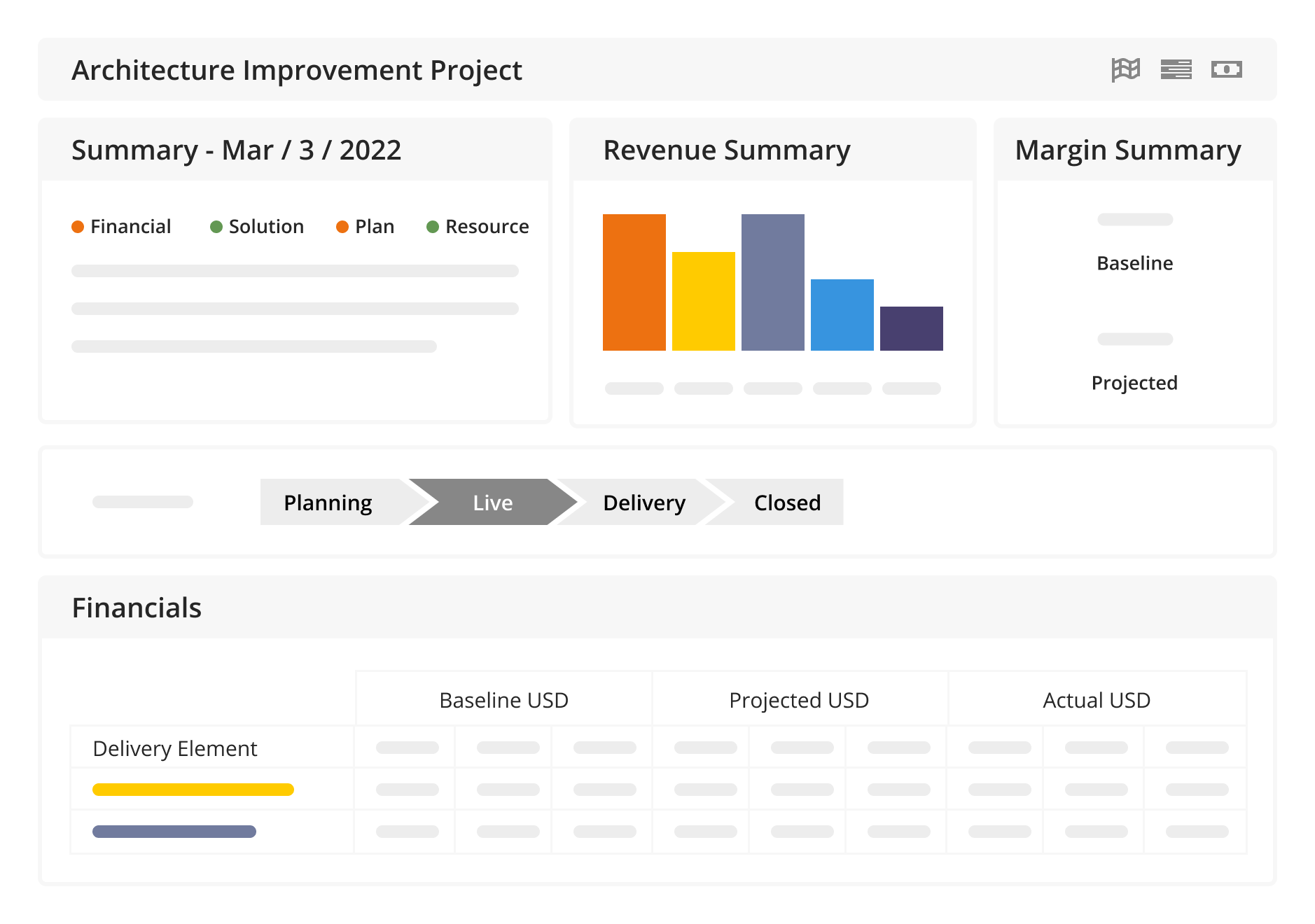
Managing projects is not easy. Choosing project management software is even harder: you’ve got thousands of options tailored for different needs, industries, and team sizes – it will take you a lifetime to study their reviews and try their free plans.
The good news is that we’ve done the work for you and reviewed 50 project management systems and got all the info you might need: features, screenshots, descriptions, pricing plans, and even the most frequent user complaints collected from software review platforms.
Bookmark this article to get back to it anytime.
Our Top 3 Picks of Project Management Software
The best project management systems embody functionality, collaboration, and flexibility. Here is the in-depth description of the criteria we used to pick our top contenders:
- A stellar project management tool should be rich in features that cater to various project management aspects, like task assignment, progress tracking, and data analysis. It strikes the balance between power and usability that turns it from a good tool into a great one.
- The software improves collaboration thanks to real-time updates, file sharing, and automated notifications that keep every team member on the same page. Because, at the end of the day, the success of a project hinges on how well the team works together.
- Adaptability in project management software is also key. The best tools flexibly mold to your project’s needs, whether you’re running a tight-knit startup or steering a complex, cross-functional initiative at a large organization. Adaptable software meets you where you’re at, growing and evolving as your projects do.
Now, let’s explore our top 3 picks:
1. actiTIME
Key features:
- Custom workflows
- Task management
- Team management
- Time tracking
- Billing & invoicing
- Reporting
- Mobile apps
actiTIME is time and project management software that offers flexible, customizable, and scalable experience regardless of your industry and company size.
actiTIME allows you to create custom work structures, workflow statuses, and user groups to meet your industry and company standards.
After you break down your projects into tasks and subtasks, you need to assign them to your team and start to track work time.
It’s also possible to create custom task fields, and adjust reports’ structure – any field and setting can be set up to meet your needs.
Besides that, the PTO blackout option in actiTIME significantly enhances project management by providing a structured approach to employee time off during critical project phases.
Clearly defining such periods right in the system, lets you set expectations for team members regarding when they should not take leave. This clarity reduces misunderstandings and encourages employees to plan their time off around crucial project milestones.
Then, you can review your project progress, costs, or profits, and analyze team performance against the set estimates and deadlines using project board views, charts, real-time widgets, and multiple reports.
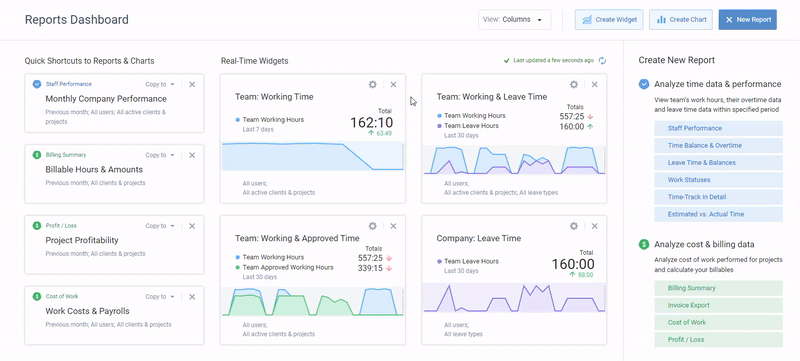
If you manage middle and large teams and projects, you can specify granular user permissions to make sure that managers have just enough user rights to manage their projects, distribute the workload, and approve employee timesheets. Regular users can’t access data outside their scope of work and responsibilities.
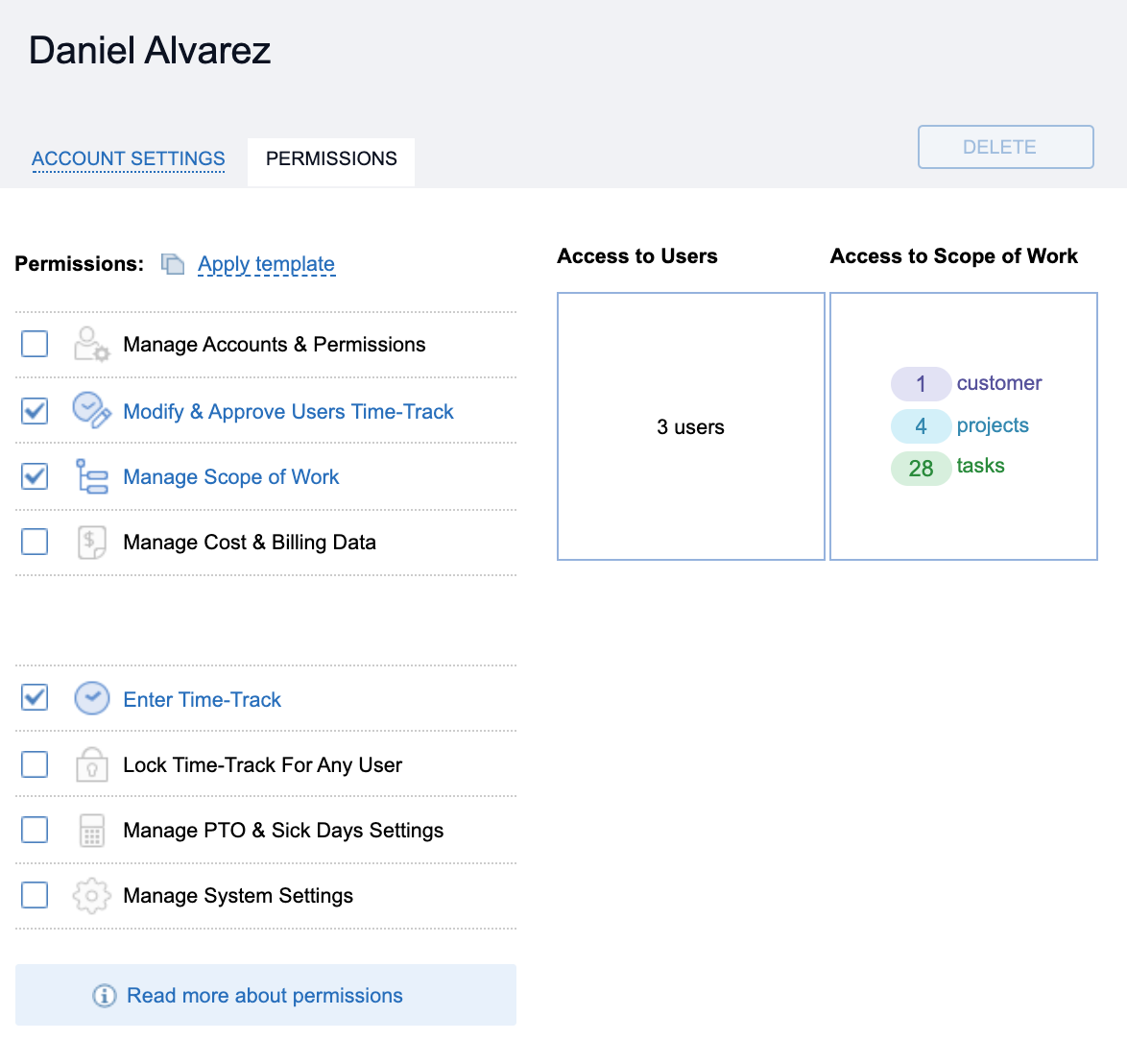
You can manage work from your browser or mobile app, get notified about changes and project events by email and mobile notifications, and exchange data across any of 4,000+ supported integrations, including QuickBooks Online, GitHub, GitLab, Jira, Trello, Evernote, Todoist, Salesforce, actiPLANS and 4,000+ more apps using Zapier – all without any technical knowledge.
You can start using actiTIME in a few clicks:
- Create or import tasks.
- Set work priorities, deadlines, and estimates.
- Attach documents to projects and write comments.
- Send out team invitations.
- Assign tasks to employees and get your team to track their time.
- Review task and project progress using Kanban board, charts, and reports.
- Analyze team performance, the use of time, and project costs.
- Create professional and error-free invoices in just a few clicks.
- Integrate your account with actiPLANS to get access to extended resource scheduling functionality.
Pricing:
- Free 30-day trial.
- Free plan for 1-3 users.
- Paid plans start at $5 per user/month.
2. Notion
Key features:
- Kanban board
- Knowledge management
- Collaboration
- Mobile apps
Notion is a project management system that connects teams, tasks, and documents in a single environment. It offers one of the most customizable content management systems where you can create a knowledge hub, a task management system with various grouping settings, roadmaps, meeting notes, task calendars, product wikis – almost anything you can set your mind to. Notion is like Evernote but more powerful.
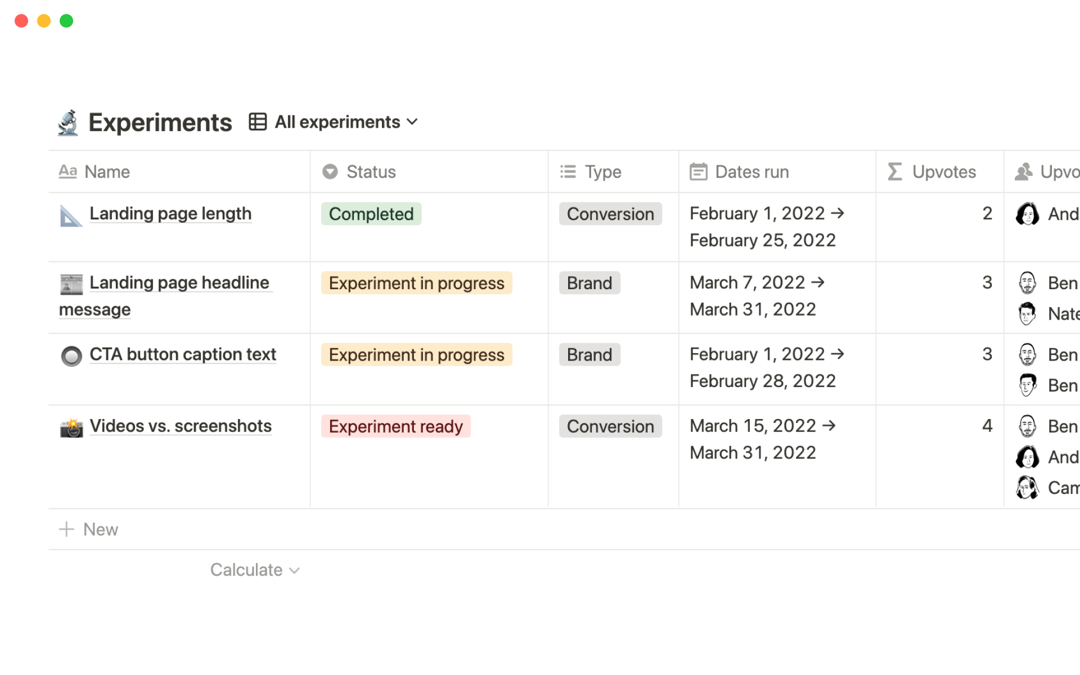
Notion makes a good fit for startups and small teams who want to save up on expensive online project management software and implement a tool that is comprehensive, flexible, and easy to use.
Pricing:
- Free version with limited functionality.
- Paid plans (without Notion AI) start at $8 per user/month.
- Notion AI costs $8 per user/month.
Advantages (according to user reviews):
- You can create custom workflows and layouts that fit the way you work.
- Intuitive calendar interface simplifies project planning.
- The feature set is truly diverse.
Disadvantages (according to user reviews):
- No data visualization tools.
- Not trustworthy notifications.
- Notion is an all-in-one software but for each of its features, there are more feature-focused competitors, which do much better.
- Difficult to navigate using the mobile app due to the rich content management capabilities and the complexity of content pages that you can create.
🎁 Grab your Free Project Schedule Template
3. Trello
Key features:
- Task management
- File management
- Checklists
- Timeline view
- Calendar view
Trello is a simple work tracking app that falls somewhere between a Kanban board app and project management software. Unlike many other picks in this list, Trello doesn’t offer advanced tools for managing projects but works well for managing small projects and work processes.

What not to expect from Trello is resource management, time tracking, workload management, different project views, and dashboards. Trello is designed for managing work the Kanban way of managing lists across different boards.
Pricing:
- Free plan with limited functionality and up to 10 workspace collaborators.
- Paid plans start at $5 per user/month.
Advantages (according to user reviews):
- Incredibly easy to use.
- Great value for the money paid.
- Customizable.
Disadvantages (according to user reviews):
- Less professional project management software.
- Not suitable for managing big projects.
- No task dependencies.
- No reporting features.
- Many features require add-ons, including time tracking and billing.
🎁 Grab your Free Work Breakdown Structure Template
Project Management Software for Startups
Project management software for startups needs to be agile, user-friendly, and packed with features that promote collaboration and efficiency:
- It should offer an intuitive interface that doesn’t require a steep learning curve – startups move quickly and can’t afford to spend too much time training on new tools.
- Flexibility is another key quality – the ability to adapt to various project methodologies like Agile, Scrum, or Kanban means that the software can grow and evolve with the startup.
- Real-time communication tools are also essential – team members should be able to collaborate effortlessly, share files, and update statuses on the go.
- Moreover, the software should provide insightful analytics and reporting features to help track progress, identify bottlenecks early, and make informed decisions.
- Last, but certainly not least, cost-effectiveness is crucial for startups operating on tight budgets. Thus, scalable solutions that offer value for money are a necessity.
Let’s see which project management systems meet these criteria:
1. nTask
Key features:
- Project planning
- Resource management
- Task dependencies
- Task statuses and priorities
- Budgeting
nTask is a robust project management software that helps teams stay organized, collaborate, and stay updated on the projects.
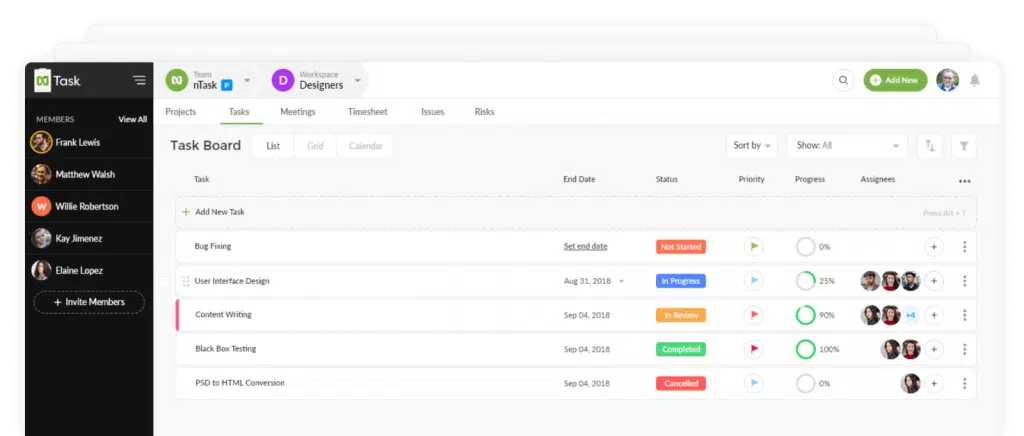
nTask facilitates project planning with resource allocation, budgeting, and work capacity tools:
- Break your projects into tasks and subtasks, prioritize and assign them to your team members, create to-do lists, and set recurring tasks to stay updated on what everyone is working on and what is left to be done.
- Visualize teamwork and project progress using a Gantt chart, and set task dependencies and milestones to make sure that your project stays on track.
Pricing:
- Free 7-day trial.
- Free Basic Plan.
- Paid plans start at just $3 per user/month.
Advantages (according to user reviews):
- Cheap price makes nTask a great value for the money paid.
- Very simple to use.
- Convenient document sharing and task management.
Disadvantages (according to user reviews):
- Not suitable for large teams.
- Lack of customization options.
- Poor customer support.
2. MeisterTask
Key features:
- Task management
- Project timeline
- Time tracking
- Mobile apps
MeisterTask is task and project management software with a focus on Agile projects. It provides a Kanban board and timeline views, to-do lists and task parameters, dashboards, and personal agenda boards where you can organize your tasks and projects to your liking.
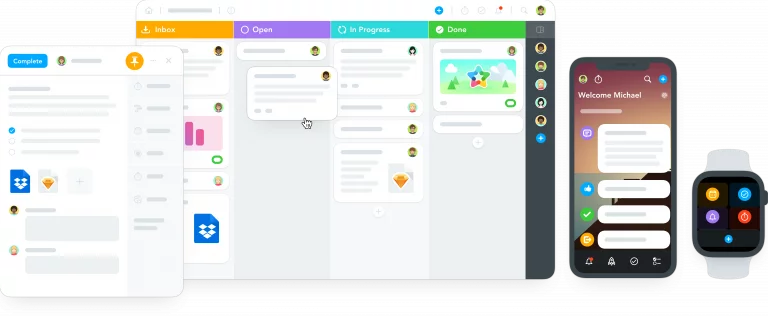
MeisterTask is a simple tool with limited functionality that will serve you best if its feature set is exactly what you’ve been looking for. Other online project management software tools can boast more advanced tools, and better customizability but a steeper learning curve. But unlike them, MeisterTask provides a free software plan that many startups can benefit from.
Pricing:
- Free Basic Plan for up to 3 projects.
- Paid plans start at £10 per user/month.
Advantages (according to user reviews):
- Ease of use.
- Excellent automation tools.
- Pleasant to look at.
Disadvantages (according to user reviews):
- Users can see each other’s time tracking records.
- Time tracking glitches.
- Task management and data synchronization bugs.
- Limited integration capabilities as compared to other solutions on the market.
- Unstable mobile apps.
3. Priority Matrix
Key features:
- Priority management
- Task management
- File management
- Reports
- Mobile apps
Priority Matrix is a project management tool based on the Eisenhower prioritization method and ensures transparency, traceability, and accountability.
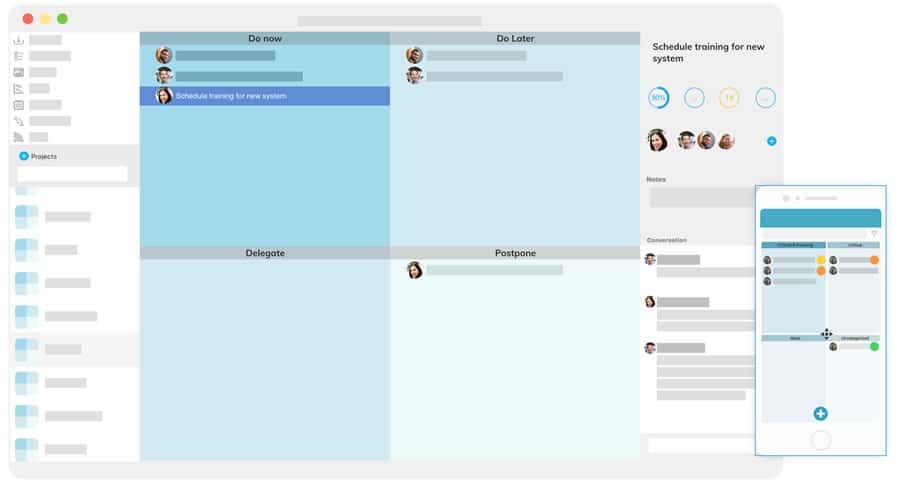
Priority Matrix does a great job at breaking projects down into tasks and helping managers review and manage them using task visualization boards, categories, and reports. Share responsibilities by assigning tasks to other team members, adding task followers, and using reports to see how they are doing.
Pricing:
- Free 14-day trial.
- Free version for personal projects and small teams.
- Paid plans start at $12 per user/month.
Advantages (according to user reviews):
- Clean interface.
- Excellent and fast customer support.
- Project visualization.
Disadvantages (according to user reviews):
- You can’t assign people, time, and money to the tasks and see their impact on the project.
- Performance issues: users report PC version crashes and synchronization issues resulting in lost data.
- No calendar view or iCal integration to review deadlines.
- Mobile apps don’t support accounts using the free plan and offer annual subscription plans, which look significantly overpriced judging by the app design, functionality, and user interface.
4. TeamGantt
Key features:
- Gantt chart
- Calendar view
- List view
- Collaboration
- Reports
- Mobile apps
TeamGantt is project collaboration and planning software for teams that relies on the Gantt chart interface.

TeamGantt relies on the Gantt chart functionality to help managers plan, schedule, and manage projects. The software promotes collaboration giving clients and team capabilities to review and collaborate on the project plan together.
To get a different perspective on the project, you can switch to the Calendar view or Kanban board project view. Get your team to log their working time across tasks and see if your project progresses according to the schedule.
Pricing:
- Free trial.
- Free plan for small teams.
- Paid plans start at $49 per manager/month.
Advantages (according to user reviews):
- Helps to see the big project picture.
- Creating project timelines takes minutes.
- Allows for visual project management.
Disadvantages (according to user reviews):
- Free plan allows for creating only 1 project and 60 tasks.
- Unpolished Kanban view and calendar view as compared to the Gantt chart.
- Lack of customizability.
- It is visually and technically clunky.
5. Nifty
Key features:
- Task management
- Roadmaps
- Knowledge management
- Reporting
Nifty is a Project management tool that boasts a free plan, great functionality and interface, and a lack of per-user pricing plans.
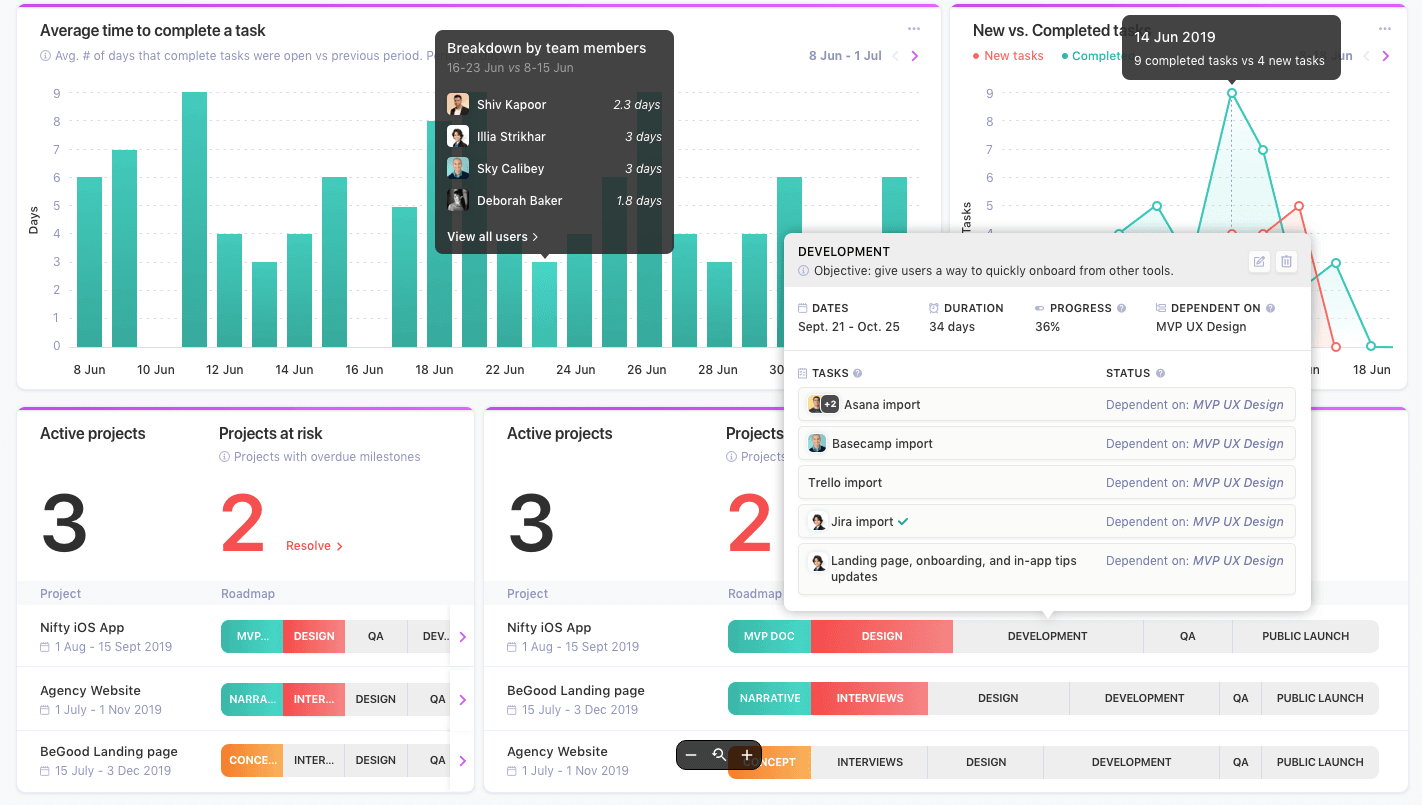
Nifty helps you plan projects using project milestones, start, and due dates that you can put on your Gantt chart. With the time tracking feature, you can see who’s working, on what, and for how long.
To limit user permissions, assign user roles with predefined sets of software permissions. Choose from various project views to review project progress: list view, board view, Gantt charts view, calendar view, and table view.
Pricing:
- Free 14-day trial.
- Free version for unlimited users.
- Paid plans start at $39 per month.
Advantages (according to user reviews):
- Superb milestone-setting feature.
- Great user experience.
- Flexible.
- Handy integration with Google Docs and Calendar.
Disadvantages (according to user reviews):
- Time tracker is buggy and inaccurate.
- Competitors offer a better number and variety of features.
- No user manual or documentation.
6. Upwave
Key features:
- Time tracking
- Team management
- Task management
- Status reports
- File management
Upwave is online project management software that helps managers distribute the workload and helps teams collaborate on projects, portfolios, and daily tasks.
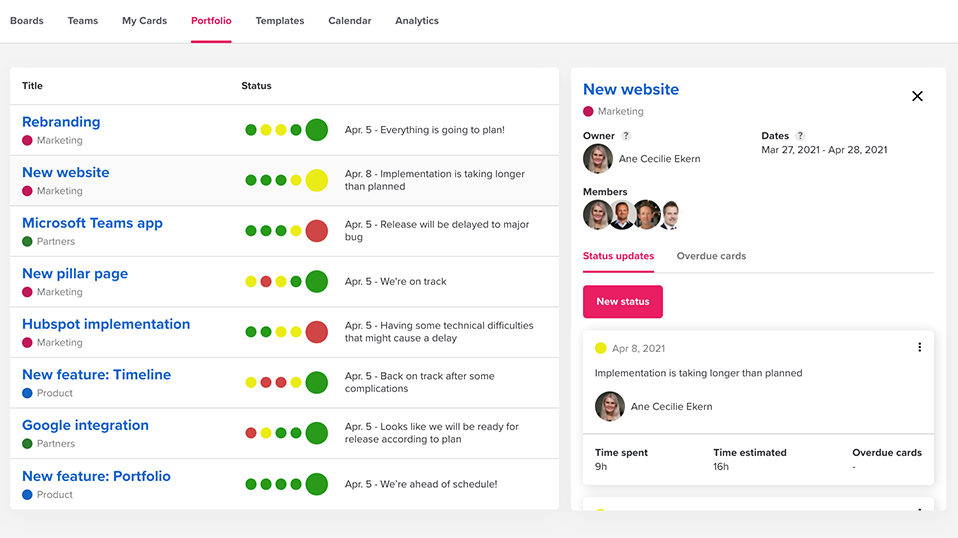
UpWave is an online workspace that helps managers distribute the workload and track project progress using project and task management tools, including start and due dates, task and project activity logs, time tracking, and estimation.
You can switch between project views (including Business Model Canvas, SWOT, Eisenhower Matrix, and Risk Matrix) to get better insight into your project health. Help teams collaborate and deliver quality results with comments, tasks following, team calendar, comments, and more.
Pricing:
- Free online trial.
- Plans start at $8 per user/month.
Advantages (according to user reviews):
- Improves team collaboration.
- Color coding helps to organize projects and tasks better.
- Clean interface.
- You can create custom boards.
Disadvantages (according to user reviews):
- No task prioritization capabilities.
- Misses out on basic features available with more established software.
7. OneDesk
Key features:
- Project planning
- Task management
- Workflow automation
- Time tracking
- Reporting
OneDesk is an online project management software for startups that supports traditional and agile project management methods.
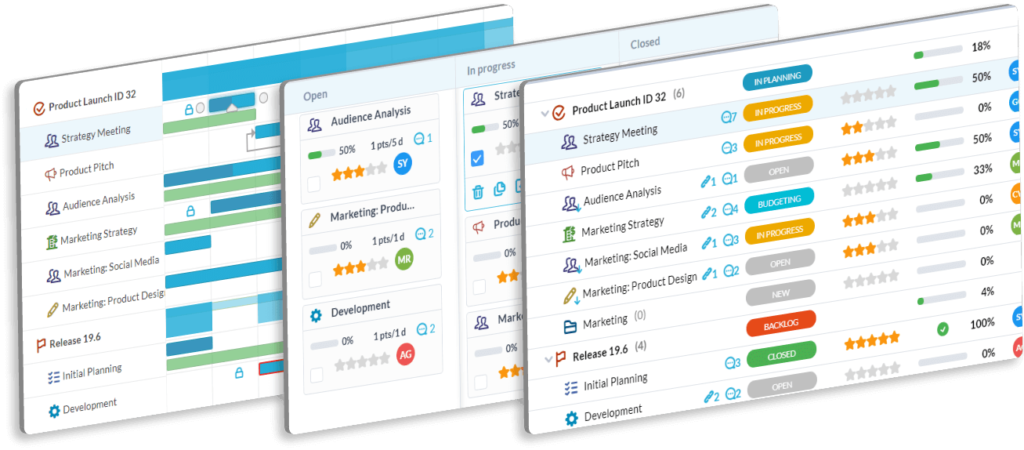
OneDesk is simple but powerful software that helps you plan out project work, cost, and assignments and schedule tasks and projects on a timeline using Gantt charts. Set up user permissions for individual users – projects with the whole team, specific team members, and customers, or keep them private. Use chats to collaborate on projects or update your clients in the same app.
Pricing:
- Free trial.
- Plans start at $11.99 per user/month.
Advantages (according to user reviews):
- Comprehensive and diverse functionality.
- Simple and user-friendly interfaces.
- Responsive customer support.
Disadvantages (according to user reviews):
- Hardly scalable as your team and projects grow.
- Minor lags.
8. Aha!
Key features:
- Custom workflows
- Agile
- Estimation
- Gantt chart
- Kanban
- Backlog management
Aha! Roadmaps is a project management module of the Aha! software suite that offers personalized startup packs with a great discount.
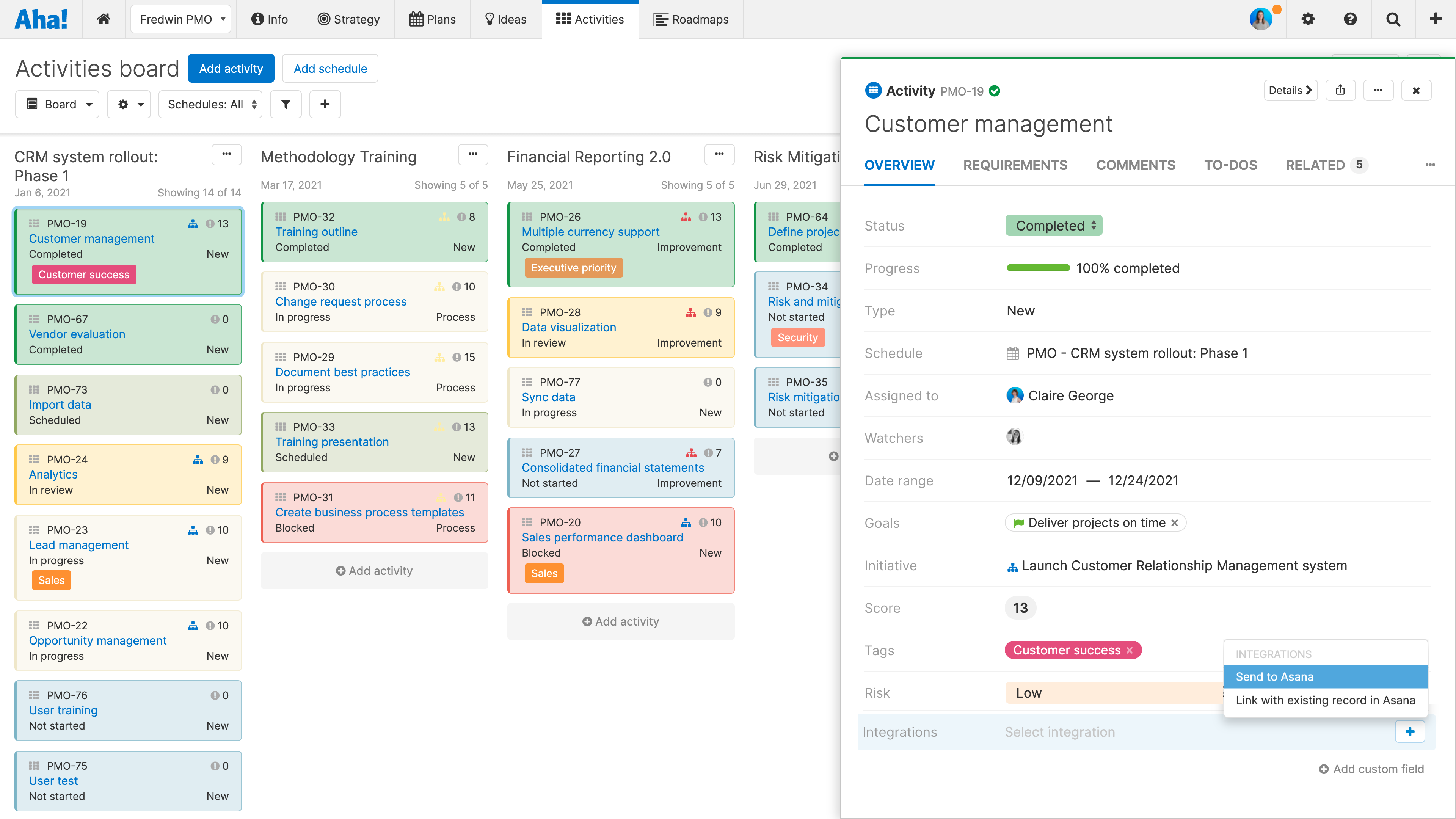
While Aha! is product development software, it offers two great modules that startups, especially developers and marketing teams can benefit from.
First of all, it is Aha! Roadmaps that helps you build your project roadmap, prioritize activities, and see how your project is doing using a Gantt chart and various other project views.
Next goes Aha! Trends. Startups are likely to enjoy this idea management module that allows you to gather feedback, review ideas, analyze their value and promote them for development.
Aha! Develop is another suite module that is worth mentioning if you manage an Agile development or a marketing team. You can create custom workflows, plan sprints, automate tasks, prioritize the backlog, and track progress.
Pricing:
- Free trial.
- The price for Aha! Develop starts at $9 per user/month.
- The Aha! Roadmaps plans start at $59 per user/month.
Advantages (according to user reviews):
- Top-tier customer support.
- The vendor understands users’ needs well.
- Comprehensive feature set.
- Can be adapted to your specific requirements and workflows.
Disadvantages (according to user reviews):
- Steep learning curve.
- The software is focused on process management, unlike other time tracking-based solutions in this list.
- Reports and dashboards could use some more customizations.
- Feature sets are sold separately so you have to pay for individual modules.
Project Management Software for Small and Medium-Sized Businesses (SMBs)
Unlike software designed for larger enterprises, which may include a vast array of features and complex integrations that require a dedicated team to manage, SMB-focused project management systems prioritize efficiency and cost-effectiveness.
They offer streamlined processes that make it easier for teams to collaborate, share files, and communicate updates without being bogged down by unnecessary complexity.
Ultimately, the best online project management software for SMBs is one that supports growth without demanding significant increases in budget for its operation and maintenance.
Here are our top picks of systems for SMBs:
1. Freedcamp
Key features:
- Task management
- Time tracking
- Gantt chart
- Kanban board
- Wiki
- Mobile app
Freedcamp is online project management software for small and medium-sized businesses specializing in digital media, marketing and consulting.

Freedcamp offers all features necessary for managing projects, including project scheduling, document and issue management, project collaboration, portfolio management, reporting, and task and time tracking. What makes it stand out from other solutions is that it has no storage limit, it offers a calendar view where you can track tasks, events, and milestones and, finally, you can track issues and do accounting.
Pricing:
- Free trial.
- Free plan for unlimited projects.
- Paid plans start at $1.49 per user/month.
Advantages (according to user reviews):
- Helpful customer support.
- Easy customization.
- Simplifies project planning.
Disadvantages (according to user reviews):
- Overcomplicated interface.
- No task dependencies/linking at the lower pricing plan tier.
- Poor mobile apps.
2. monday.com
Key features:
- Kanban
- Calendar
- Timeline
- Gantt
- Mobile apps
monday.com is many things in a single place: it’s project management software, a software development program, a sales and CRM suite, an HR management tool, and more.
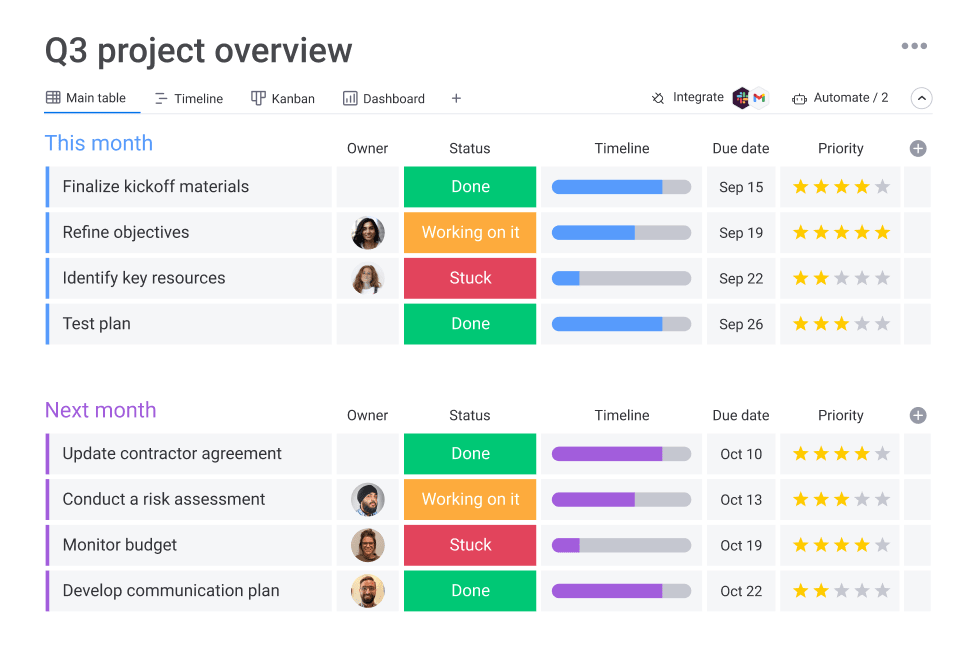
The software is focused on task management and offers workplaces, teams, boards, items, and subitems. To visualize project progress, you can choose between Gantt charts, Kanban boards, timelines, and calendars.
Pricing:
- Free version for up to 2 seats.
- Paid plans start at $9 per seat/month.
Advantages (according to user reviews):
- Good customer support.
- Easy to use and visually pleasing.
Disadvantages (according to user reviews):
- Only a 14-day trial though the the learning curve is steep.
- You can add users in increments of 5 meaning you’ll pay for users that you don’t use.
- Recurring tasks are available only at high-tier subscription plans.
- Poor reporting options and their customization.
- Expensive for large teams.
3. Runrun.it
Key features:
- Task management
- Workflow management
- Gantt view
- Performance reports
- Cost reports
Runrun.it is process and project management software that relies on time tracking for project planning and offers numerous interfaces for data visualization.
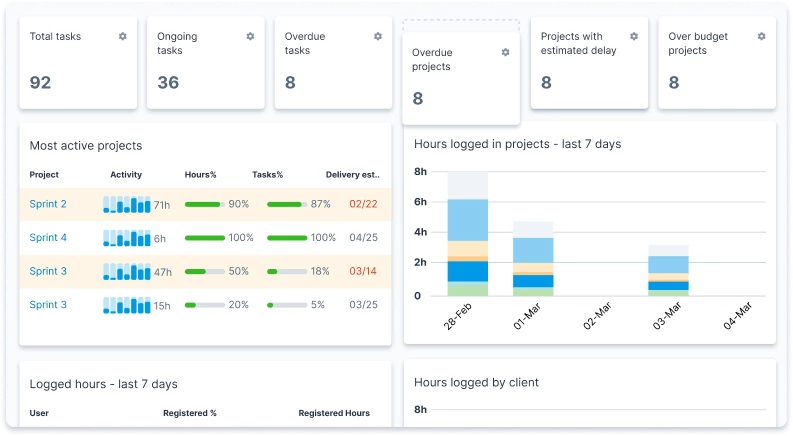
Runrun.it offers easy project management and is best suited for Agile projects. The software processes time expenses, calculates available employee capacity, and displays it with the Gantt chart view. The software also offers a single project collaboration environment where you can discuss ideas and share files. Use Kanban boards and reports to keep track of your projects.
Pricing:
- Free 14-day trial.
- Free plan for up to 5 users.
- Paid plans start at $8 per user/month.
Advantages (according to user reviews):
- Frequent product updates.
- Many features can be customized.
- The time tracker is easy to use.
Disadvantages (according to user reviews):
- Steep learning curve.
- Not intuitive, complicated interface.
- Creating new tasks is time-consuming.
4. Kissflow Project
Key features:
- Kanban view
- Task management
- Reports
- Activity history
Kissflow Project is a collaborative online project management software that helps small and middle-size businesses plan and manage resources and projects.
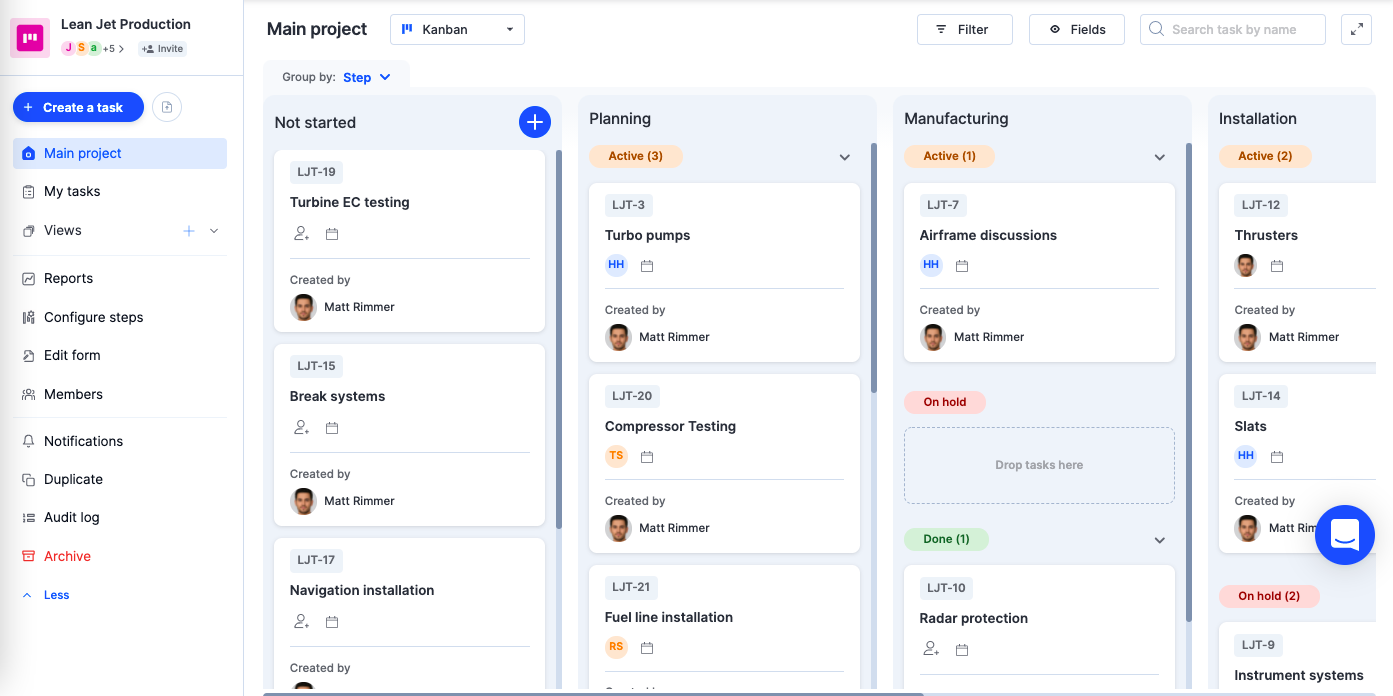
Kissflow Project allows managers to create and assign tasks and use Kanban boards, task lists, and matrix view to visualize and track project progress. Managers and team members will benefit from organizing tasks according to their due dates, priorities, and assignees, while reports will reveal bottlenecks, estimate task completion rates, and measure team productivity.
Pricing:
- Plans start at $1.500 per month.
Advantages (according to user reviews):
- Excellent customer support.
- Simplifies task delegation.
Disadvantages (according to user reviews):
- Steep learning curve.
- You need to be tech-savvy to set up some functionality.
5. Kantata
Key features:
- Resource management
- Team collaboration
- Business intelligence
Kantata (formerly Mavenlink) is an online project management software designed for professional services organizations.
With Kantata, you can review and manage resources: align skills with project demands, see how adjustments impact performance and profit, and forecast resource utilization.
Switch between the interfaces to get a bird’s eye view of your projects or drill down to the task level. Automate your processes by creating reusable templates and workflows and building workarounds. Use charts and reports to align schedules, scopes, and budgets, get real-time status insight and forecast better.
Pricing:
Contact the vendor for details.
Advantages (according to user reviews):
- Good permission controls.
- Responsive customer support.
- The software is constantly evolving and getting better.
- Exception timesheet management functionality.
Disadvantages (according to user reviews):
- Reports are not real-time: they update every few hours.
- Reports must be exported, downloaded, opened in Excel, and manipulated in order to see anything meaningful.
- Long initial software configuration.
- No mobile apps.
6. Microsoft Lists
Key features:
- Assets management
- Issues tracking
- Automation
- Mobile apps
Microsoft Lists is not a list app as the name suggests. It allows you to track issues, routines, assets, inventory, contacts – everything for a successful project delivery.

In Microsoft Lists, you can apply if/then-style rules to individual items or tasks on your list, such as words like completed, pending, blocked, issue, priority, etc. After any edits have been made to the task, the software will update you about the item status.
Microsoft Lists is a part of the Microsoft Suite, meaning it merges your lists with all Microsoft 365 apps so that you can start creating or working on your data from Microsoft Teams, SharePoint, or Lists home.
Pricing:
- Plans start at $6 per user/month.
Advantages (according to user reviews):
- The mobile app is easy to use.
- Works in perfect sync with the Microsoft Suite.
- Flexible settings.
Disadvantages (according to user reviews):
- Complicated setup and maintenance.
- Requires employee training.
- Poor search capabilities.
7. Planisware Orchestra
Key features:
- Demand management
- Resource management
- Project planning
- Cost management
- Collaboration
- Reports
Planisware Orchestra is project management software for middle-sized businesses that helps managers maintain and maximize project health and performance.
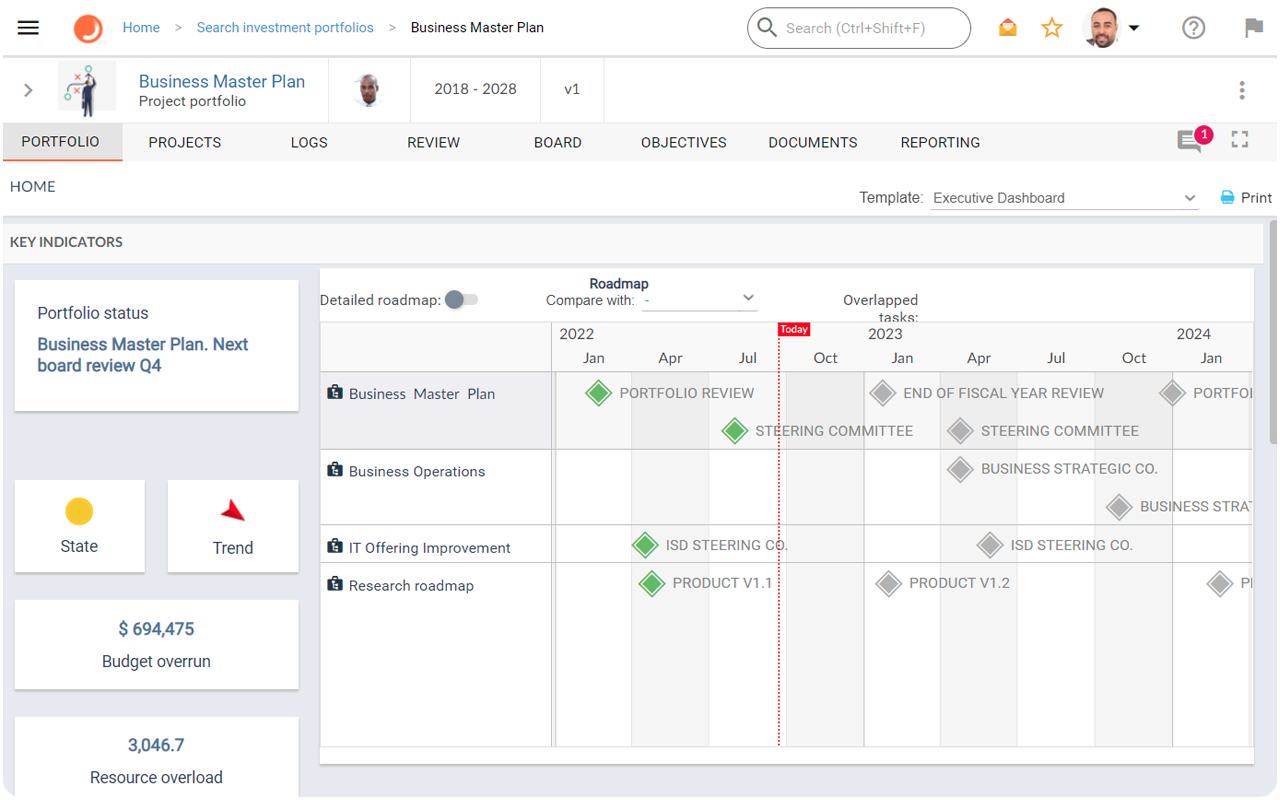
Planisware Orchestra helps you plan projects, manage schedules, and combine various project management methodologies. Unlike other solutions in this list, it offers idea management functionality, meaning you can evaluate the strategic values, costs, and challenges of each idea. Manage project budget and talents by relying on resource capacity and budget analytics.
Pricing:
- Contact the vendor for details.
Advantages (according to user reviews):
- Customizable.
- Versatile feature set.
- Stable performance.
Disadvantages (according to user reviews):
- Poor report customization capabilities.
- Some processes are overcomplicated and require too much clicking.
- Poor software documentation.
8. Celoxis
Key features:
- Project planning
- Project tracking
- Accounting
- Portfolio management
- Resource management
Celoxis is a project management solution for small and middle-size businesses with 20+ years of experience in the market.
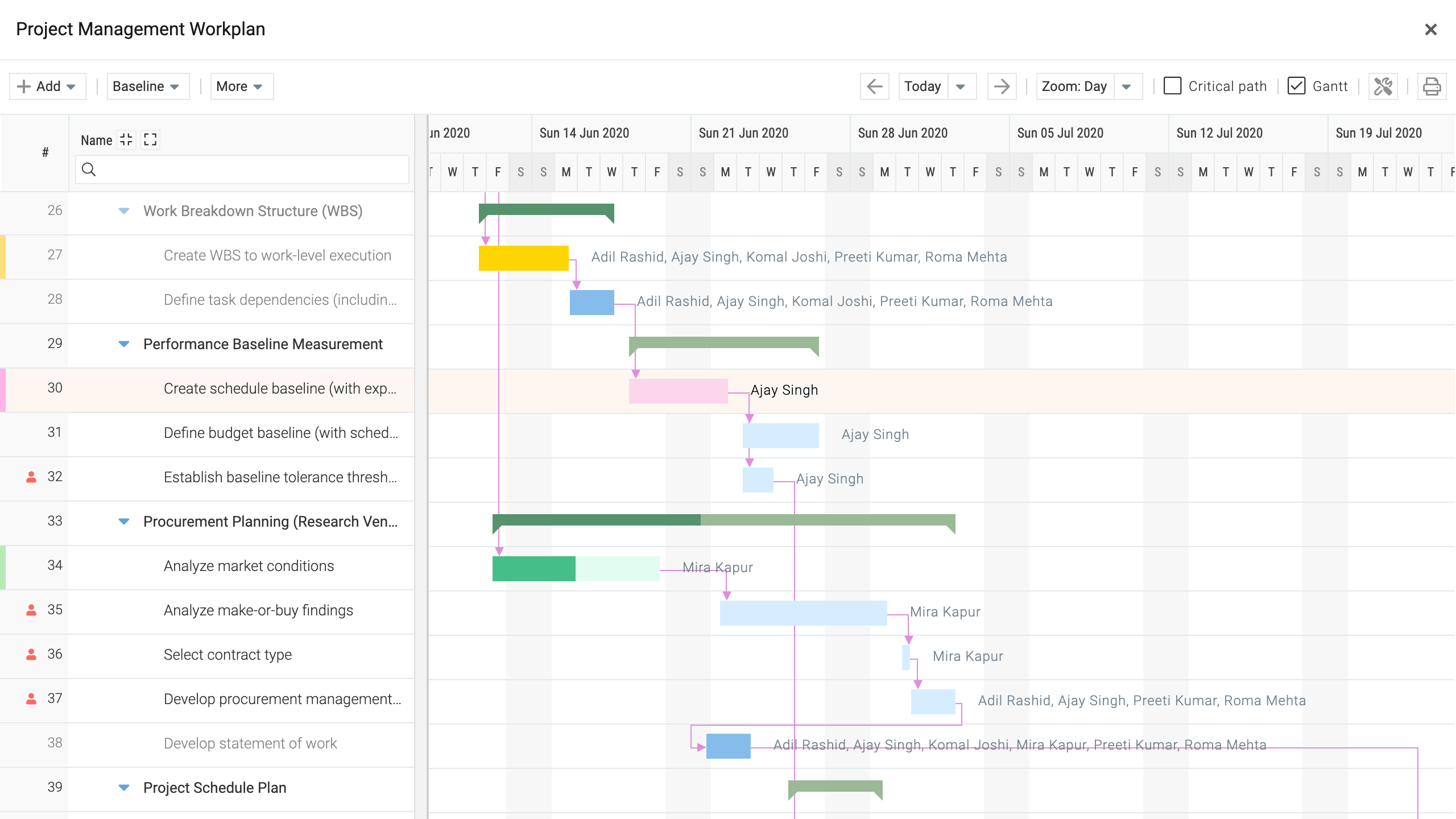
Celoxis helps managers plan and track projects using tools like scheduling, Gantt charts, inter-project dependencies, and critical path analysis:
- Allocate human resources based on their availability, demand, and skills, and get notified if anyone gets overloaded.
- Use charts, reports, and widgets to review your team’s productivity and project health.
- Stay updated on the project on the go using dedicated mobile apps.
Pricing:
- $25 per manager/month.
- $15 per employee/month.
Advantages (according to user reviews):
- Convenient layout.
- Versatile feature set.
- Simplifies project planning.
Disadvantages (according to user reviews):
- Not suitable for Agile processes.
- Broken Gantt chart export: you get a section of the chart cut randomly.
- There isn’t any customization around the expenses.
- No mobile apps.
Project Management Software for Enterprises
When scouting for enterprise-level project management software, there’s a golden quartet of qualities to keep an eye out for:
- Multifunctionality. You’re not just juggling projects – you’re managing resources, tracking progress, and probably a dozen other things. Thus, your perfect software should be versatile enough to handle everything you throw at it without breaking a sweat.
- Scalability. Your tool of choice should grow with you, seamlessly adapting as your company scales from a few teams to a global workforce without skipping a beat.
- Robustness. The project management system needs to keep pace with your busiest days without glitching under pressure. It’s that rock-solid reliability that means deadlines are always smashed on time.
- Data security. Your project data is as precious as gold, and the ideal software not only guards this treasure against digital pirates but also ensures you’re complying with the latest data protection regulations.
Now, let’s check out some options that meet these criteria:
1. Rally Software
Key features:
- Agile project management
- Roadmap planning
- Capacity planning
- Quality management
Rally Software is enterprise agile development software that helps organizations collaboratively plan, prioritize, and track development work.
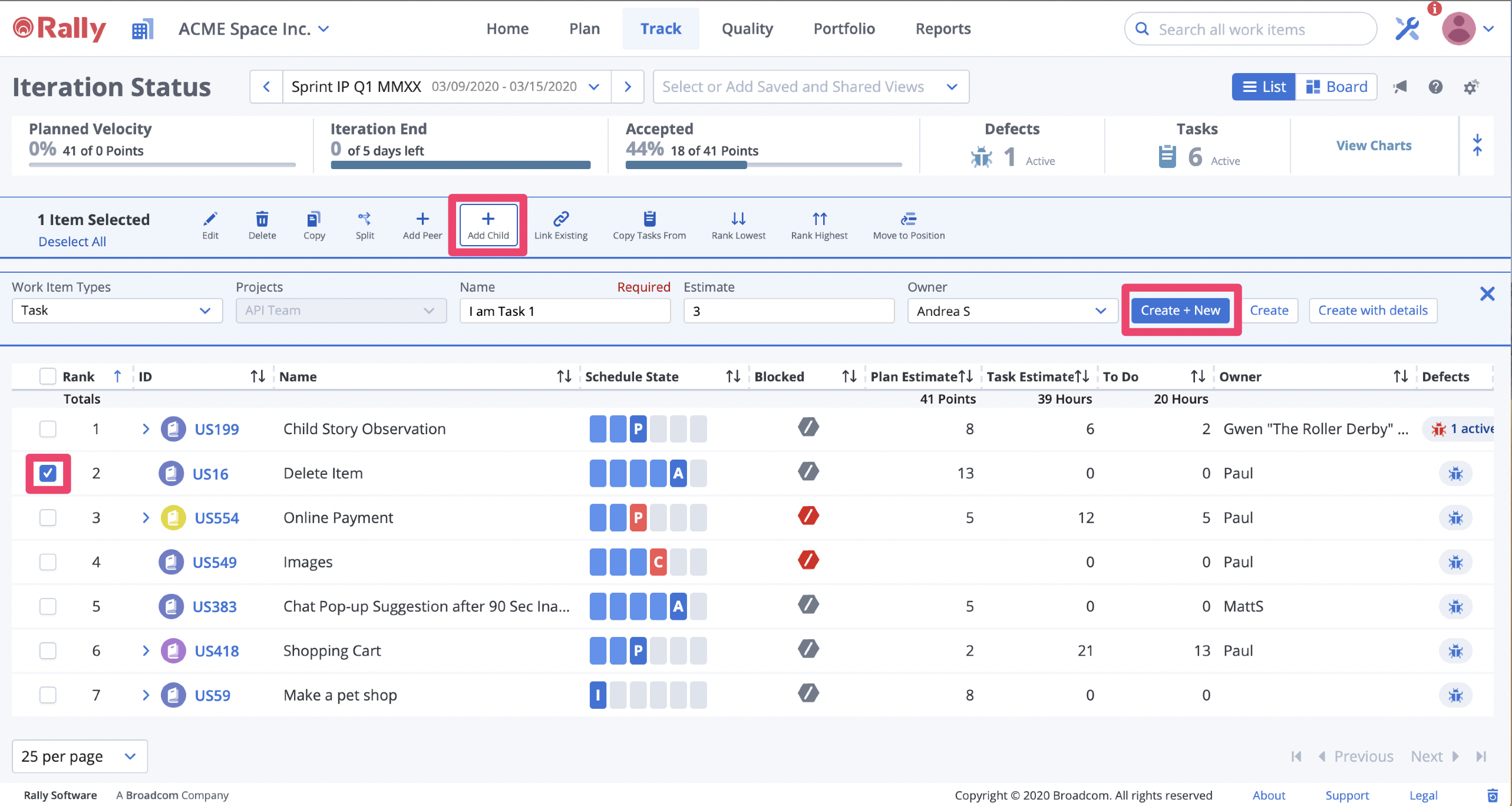
Rally Software helps managers, executives and leaders create purpose-driven plans with Portfolio Kanban Boards that display item status and workflow, while the Milestones feature lets users plan and track feature work against critical delivery dates.
Refine and prioritize project backlog and assess potential risks and dependencies issues. Use capacity planning, team planning, team board, iteration status monitoring, and more to streamline your enterprise processes.
Pricing:
- Contact the vendor for current prices.
Advantages (according to user reviews):
- Helps to boost efficiency and collaboration.
- Facilitates company-wide communication.
- Perfect for agile project management in software development projects.
Disadvantages (according to user reviews):
- Difficult initial setup process.
- The price isn’t very competitive.
- No mobile apps.
2. Asana
Key features:
- Timeline view
- Kanban board
- Goal tracking
- Workload management
- Mobile apps
Asana is an online project management software designed for enterprise users that streamlines communication and organizes projects.

Asana can do many things but first of all, it is known for its task and project management capabilities. Create and assign tasks to responsible people, put them across different boards, see them in a timeline, and design reusable templates to make certain tasks easier to start.
Pricing:
- Free version for personal use.
- Paid plans start at $10.99 per user/month.
- Enterprises get a custom quote.
Advantages (according to user reviews):
- Clean and visually appealing interfaces.
- Makes it easy to track multiple projects.
- Great task prioritization feature.
Disadvantages (according to user reviews):
- Steep learning curve.
- Many features but most of them are too basic.
- Lack of time tracking – an essential tool for project planning and monitoring.
- Not the best fit for developer teams because it lacks GitLab and GitHub integrations.
- Too many email notifications.
3. LiquidPlanner
Key features:
- Portfolio management
- Task management
- User permissions
- Change tracking
LiquidPlanner is project management software for teams that want to prioritize activities and predict project performance.
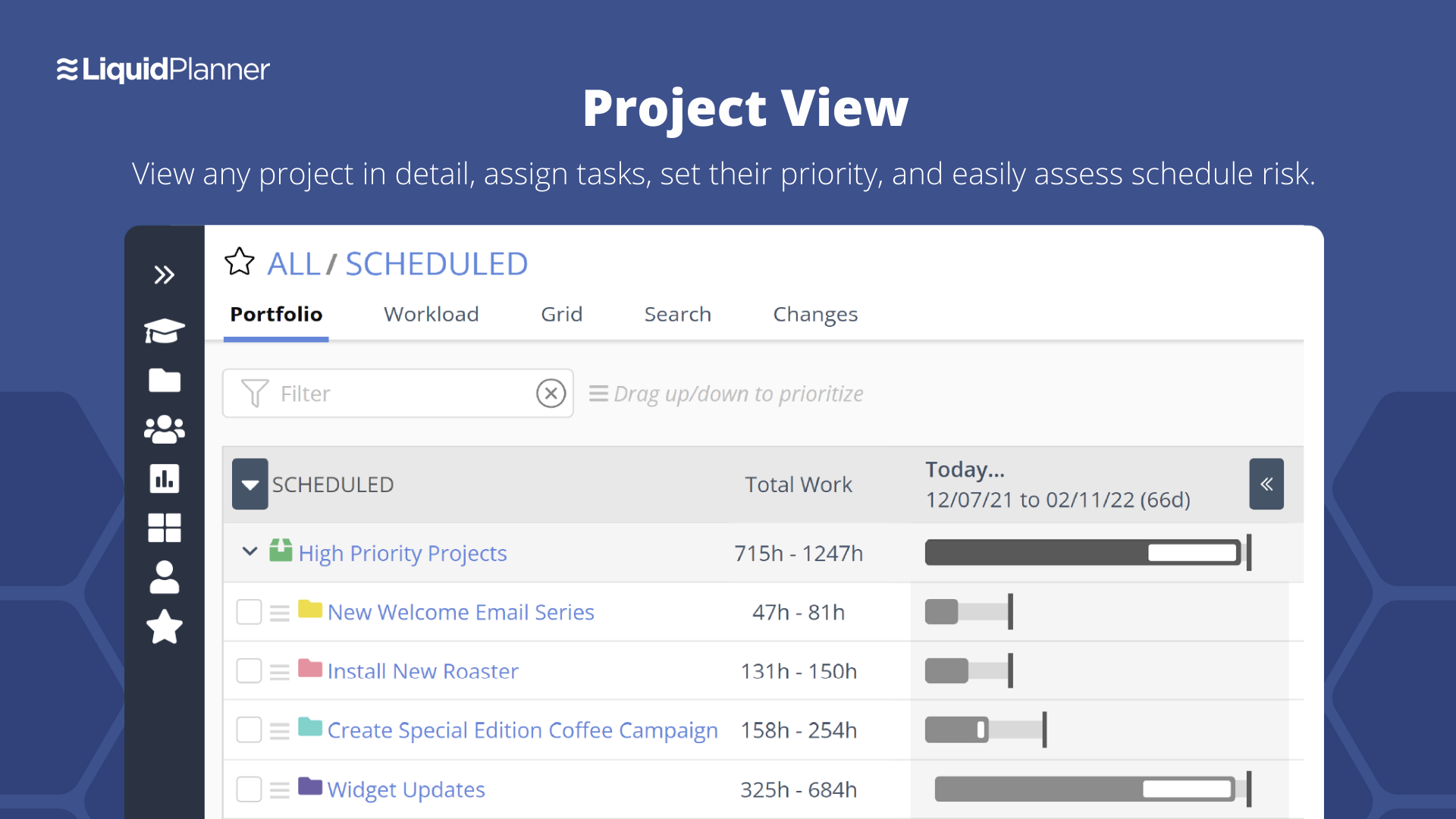
LiquidPlanner is a good fit for companies dealing with several concurrent projects, changing priorities, and resource allocation. It is designed to adjust priority, completion dates, and other parameters across tasks after you make changes to a single item. It also promotes stakeholder participation through project dashboard sharing.
Pricing:
- Free 14-day trial.
- Plans start at $15 per user/month.
Advantages (according to user reviews):
- Excellent customer support.
- Frequent product releases and improvements.
- Combines resource planning with project tracking.
Disadvantages (according to user reviews):
- Difficult to manage many projects.
- Time-consuming setup, deployment, and maintenance.
- No change log or notifications for changes.
- Reporting is difficult to use.
- Poor mobile apps.
4. Adobe Workfront
Key features:
- Work Management
- Portfolio management
- Demand management
- Resource management
- Reports & dashboards
- Mobile apps
Adobe Workfront is online project management software that connects strategy to delivery, integrating people and data across enterprises.

Adobe Workfront automates repeatable workflows by allowing you to build custom templates so that you can focus on achieving goals instead of building reports or updating work. Use analytics tools to identify bottlenecks and delays before they happen. Get your team to use collaboration tools, manage their work, and make decisions in a single place.
Pricing:
- Contact the vendor for the pricing information.
Advantages (according to user reviews):
- Diverse functionality.
- Amazing customer support.
- Task-setting flexibility.
- Intuitive user interface.
Disadvantages (according to user reviews):
- The initial setup is time-consuming and challenging.
- Teams require training to use the software.
- No offline access.
5. Apptio Targetprocess
Key features:
- Progress monitoring
- Custom workflows
- Kanban board
- Time tracking
- Budgeting
Apptio Targetprocess is enterprise agile planning software that supports popular frameworks including Scrum, Kanban, SAFe, and LeSS, and accelerates enterprise agile transformation.
Apptio Targetprocess offers strong analytics tools and user roles and permissions functionality that helps leaders review project health and align using a dashboard and inform stakeholders about the project progress. Review project costs, allocate budgets, and see strategic theme costs and predictions.
Apptio Targetprocess provides a hawk’s-eye business overview for executives with performance charts, team value charts, and other analytics tools. Apptio Targetprocess is recognized in Gartner’s Magic Quadrant for Agile Enterprise Planning Tools.
Pricing:
- Contact the vendor for current prices.
Advantages (according to user reviews):
- Good options for software integration.
- Customizable.
- Scalable.
- Well-designed reports.
Disadvantages (according to user reviews):
- Steep learning curve.
- No mobile apps.
6. Planview AgilePlace
Key features:
- Work visualization
- Kanban
- Work statuses
- Risk management
- Work in process limits
Planview AgilePlace is enterprise project management software that helps organizations track and manage the flow of work from strategy to delivery.

The software provides end-to-end project visibility with Kanban boards where you can review work priority and status regardless of the project management methodology and workflow.
It visualizes work and work-in-progress to help teams plan their work, manage delivery, and adapt to changes. You can use card connections to manage dependencies and the flow of work, and see risks.
Pricing:
- Free online trial.
- Contact the vendor for detailed pricing information.
Advantages (according to user reviews):
- Great data and project visualization.
- Configurable and easy to use.
- Suitable for agile project management.
Disadvantages (according to user reviews):
- Not suitable for small and simple projects.
- Some of the reporting features were hard to customize or modify.
- Steep learning curve.
7. Basecamp
Key features:
- Project templates
- To-do lists
- Shared schedule
- Team collaboration
- File management
Basecamp is online project management software for middle-sized companies and enterprises with a great focus on team collaboration.
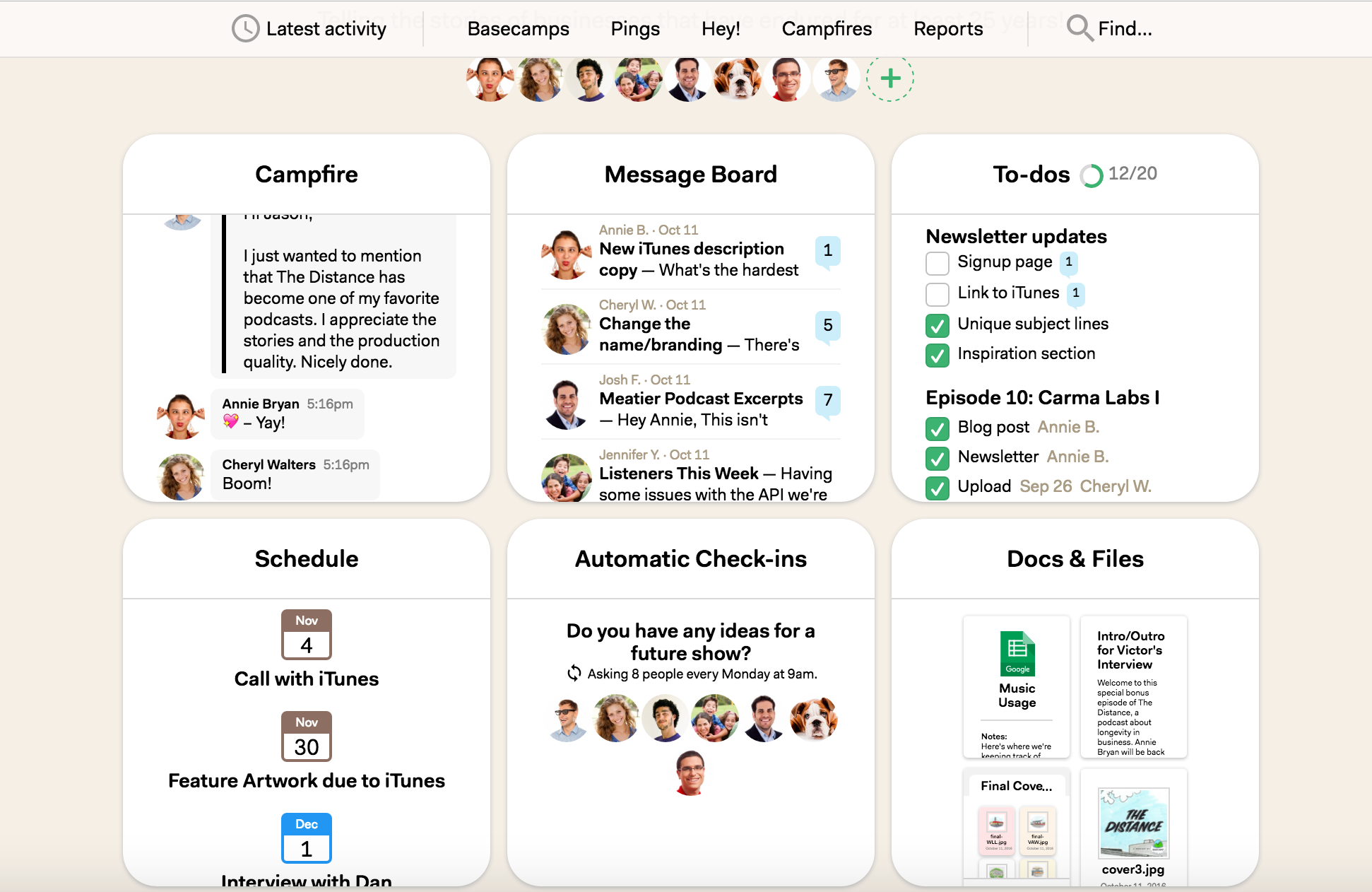
Basecamp boasts its ability to replace communication, project management, file management, and other tools with subscription plans for the price of the single software that covers all these needs. Unfortunately, it fails to put it into action.
For example, you can’t manage projects successfully if you don’t manage time and other resources, and Basecamp offers no time tracking features but integrations to subscription-based services. Ironic, right?
Still, Basecamp can be worth your time if you are looking for a collaboration and communication hub. Luckily, you can give it a try for free, because it offers a free trial.
Pricing:
- Free 30-day trial.
- Paid plans start at $15 per user/month.
Advantages (according to user reviews):
- Fair price.
- Simplicity.
- Promotes visibility into projects and tasks.
- Very handy group chat feature.
- Can be used to involve clients in the project management cycle.
Disadvantages (according to user reviews):
- Lack of any time tracking capabilities – only integrations.
- Poor task management: Basecamp does not provide enough dimensions for tracking the status of a task, including the responsible person, their progress, and task status.
- The software interface is different from other tools, which makes it feel unintuitive and clunky.
- Limited software integrations, which restricts multidimensional projects.
Project Management Software for IT Teams
Looking for online project management software for your IT team?
- It must be intuitive because nobody has time for a steep learning curve when deadlines are tight.
- Since IT projects rarely happen in silos, the software also needs robust collaboration features like real-time updates, file sharing, and communication tools.
- Seamless integration with third-party tools is a must-have. Your software should play nice with the platforms you already rely on (i.e., code repositories, CI/CD pipelines, and cloud services).
- And don’t forget about flexibility. You should be able to adapt the software to your project management methodology, be it Agile, Waterfall, or something in between.
Here are the best project management systems to consider:
1. Azure Boards
Key features:
- Agile project management
- Backlog management
- Kanban
- Product road mapping
- Reporting
Azure Boards is online project management software for software development teams, and it is a part of Azure DevOps Services.

Azure Boards is designed for managing Agile, Scrum, and Kanban processes and tracking various types of work, including user stories, bugs, features, and epics.
Use Boards to add, update, and track item statuses, go to the Backlogs interface to add, prioritize, organize, and assign work, build Sprints for the Scrum process, and check out the Delivery Plans hub for calendar views and dependencies.
Pricing:
- Free trial.
- Contact the vendor for detailed pricing information.
Advantages (according to user reviews):
- A lot of features under one package.
- You can extend the functionality further with add-ons.
- Seamless integration with many other software development tools.
Disadvantages (according to user reviews):
- Azure DevOps can be a little tricky to master since it does virtually everything but requires following through.
- Reporting for assessing work could be more in-depth.
- Search and filtering are limited to pre-defined options.
2. Bitbucket
Key features:
- Team collaboration
- Git code management
- Change management
- Quality assurance
- Granular user permissions
Bitbucket is a project management software that gives developer teams one place to plan projects, collaborate on code, test, and deploy.
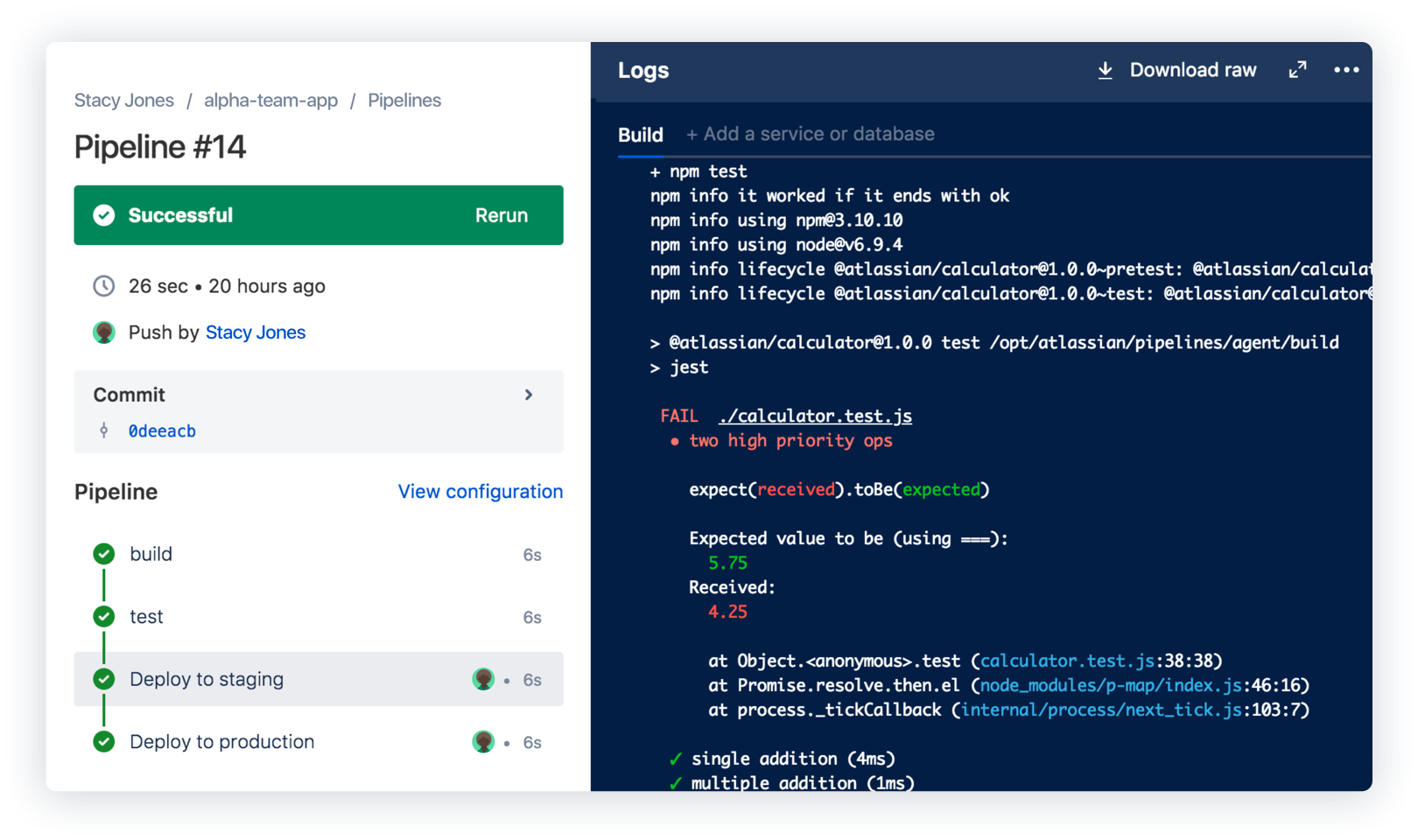
Bitbucket serves well for Git version control, pull requests, and code reviews. Also, it makes a great addition to JIRA. For example, JIRA can automatically close tickets once you merge or accept a pull request. Sounds great, right?
Pricing:
- Free for up to 5 users.
- Paid plans start at $3 per user/month.
Advantages (according to user reviews):
- Streamlines the Git experience.
- Great interface.
- Seamless integration with the Atlassian suite.
- Customizable access controls.
Disadvantages (according to user reviews):
- Not as stable as GitHub
- Steady learning curve and tricky configuration
- Best for teams who already use the Atlassian ecosystem
- Few integrations with software outside of the Atlassian suite.
3. Backlog
Key features:
- Code management
- Issue management
- Gantt charts
- Quality assurance
- Burndown charts
- Git graphs
- File sharing
Backlog is an issue tracking and project management software for development teams. It offers project progress charts and boards, bug tracking tools, version control features, wiki management, and more.
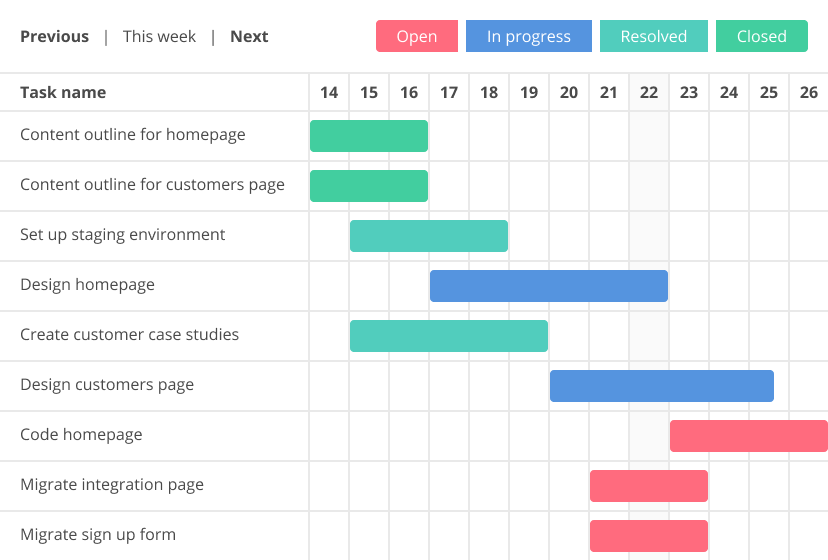
Backlog integrates with Git and SVN helping developers manage the project’s source code along with project tasks. Other integrations include Typetalk, Cacoo, Redmine, Jenkins, and more.
Pricing:
- Free 30-day trial.
- Free version for up to 10 users.
- Paid plans start at $35 per month.
Advantages (according to user reviews):
- Neat design.
- All the necessary features.
- Simplifies bug identification.
Disadvantages (according to user reviews):
- You can’t track time spent on subtasks.
- Sometimes the search feature doesn’t work as intended.
- You can upload only one file per task.
4. Jira Work Management
Key features:
- Task dependencies
- Bulk changes
- Timeline view
- Versions
- Board view
- Approvals
Jira Work Management is an upgrade and rebranding of the Jira Core Cloud product. It is online project management software for development teams designed for Agile teams.
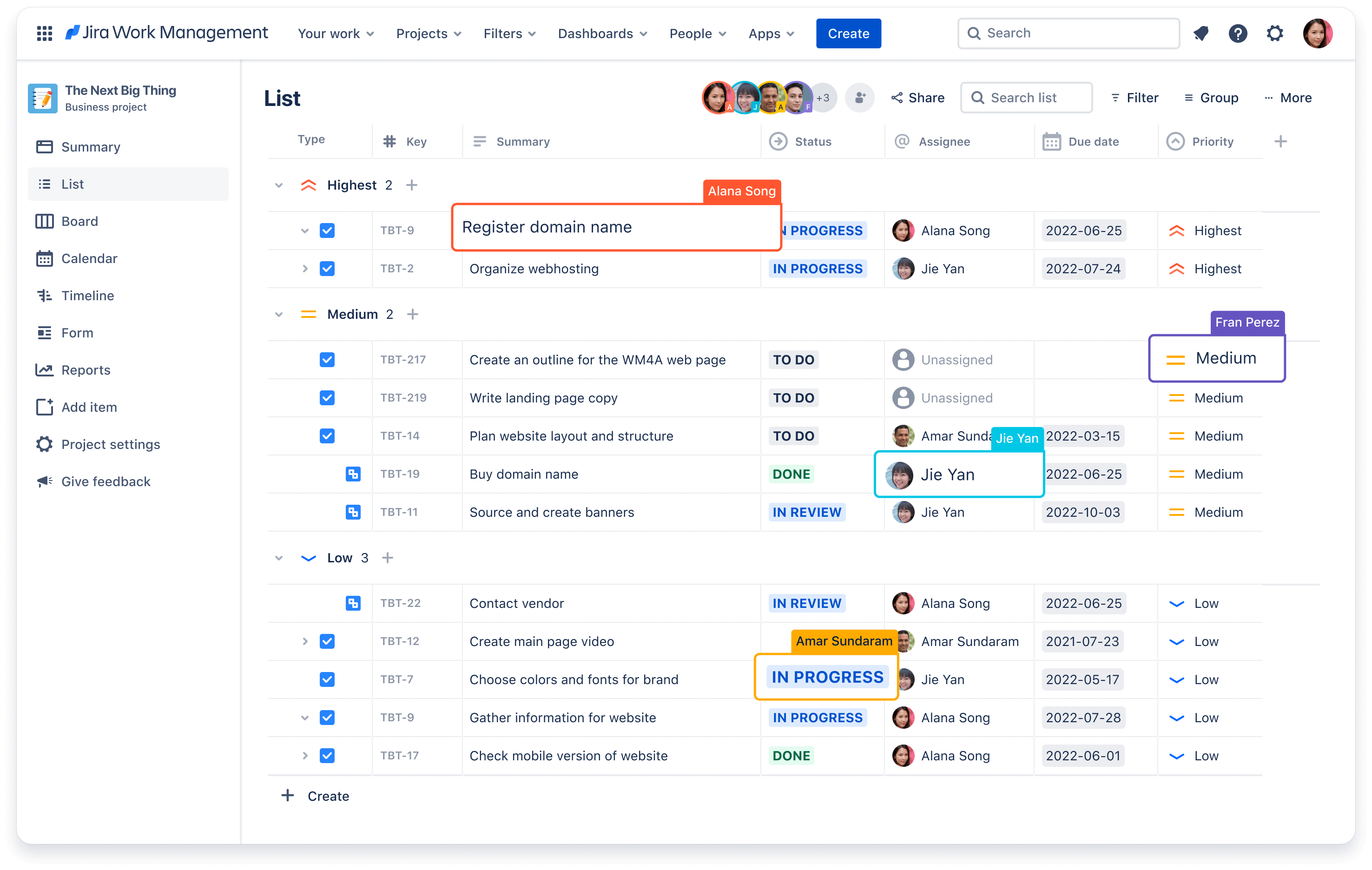
JWM puts focus on task management and work visualization by offering several work views – a task list view, a calendar view, a timeline view, and a board view – form builders like those of Google Forms and ready-to-use templates.
More than that, in JWM, you can edit items in bulk, divide tasks into subtasks, set up automated approvals, and use charts and reports to visualize your project progress and resources.
Pricing:
- Free plan for 10 users.
- Paid plans start at $5 per user/month.
Advantages (according to user reviews):
- Streamlines task management.
- Ideal options for agile project teams.
Disadvantages (according to user reviews):
- No time tracking for tracking your progress.
- Poor story points tracking and backlog organization.
- Slow and not intuitive interface.
5. Planisware Enterprise
Key features:
- Roadmapping
- Scenario comparison & optimization
- Resource management
- Issue management
- Milestone tracking
- Time tracking
Planisware is project management software designed for large product development projects, engineering teams, and IT organizations. It brings together budgets, forecasts, schedules, and resources.
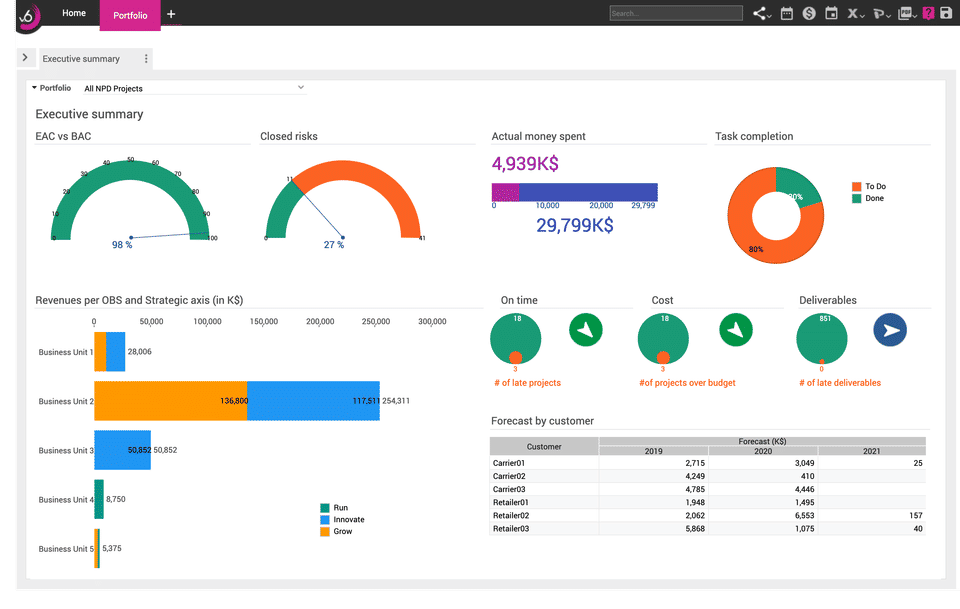
Planisware helps managers build projects and assess results using roadmaps, budgets, and investment buckets. Capacity planning, resource scheduling, and time tracking will provide you with visibility and manage resources. To make sure that your project is on track, control it using scheduling, costs, and deliverable management.
Pricing:
- Contact the vendor for details.
Advantages (according to user reviews):
- Flexible and customizable.
- Consolidates DevOps tools.
- All-around feature set.
Disadvantages (according to user reviews):
- No recurring task management.
- Not suitable for small businesses.
- Few software integrations.
- Stability issues.
6. Squish
Key features:
- Task management
- Workflow statuses
- Issue management
- User permissions
Squish is a project management tool with flexible task management and user permission settings.

Squish puts focus on issue management: it allows you to review the entire history of an issue, including comments, attachments, and field changes, save and share searches for quick access, and generate custom issue statistics. More than that, you can set up notifications to let other users know when an issue has been updated.
Pricing:
- Free trial.
- Plans start at $600 per year.
Advantages (according to user reviews):
- Easy to use and set up.
- Improves team collaboration.
Disadvantages (according to user reviews):
- Inability to perform a search across multiple projects.
- It only accepts attachments up to 2 MB.
- No mobile app support.
Project Management Software for Construction
Project management systems for construction must be as robust and dynamic as the projects it’s designed to manage:
- It should have top-notch scheduling features because timing is everything in construction. It’s not just about what needs to be done but when and in what order.
- The software should offer real-time updates too – in construction, things change fast, and you’ve got to adapt quickly.
- Document management is another must-have. You want a system that keeps all your contracts, blueprints, and change orders well-organized and easy to access.
- Lastly, it should have solid mobile functionality. Construction work doesn’t happen behind a desk, so the ability to manage the project from the field is a game changer.
Here are the top contenders in this software category:
1. Fieldwire
Key features:
- Plan viewing
- Task management
- Scheduling
- Reports
- Mobile apps
Fieldwire is job site management software for construction teams. It facilitates task management, plan viewing and versioning, issue tracking, and team collaboration.
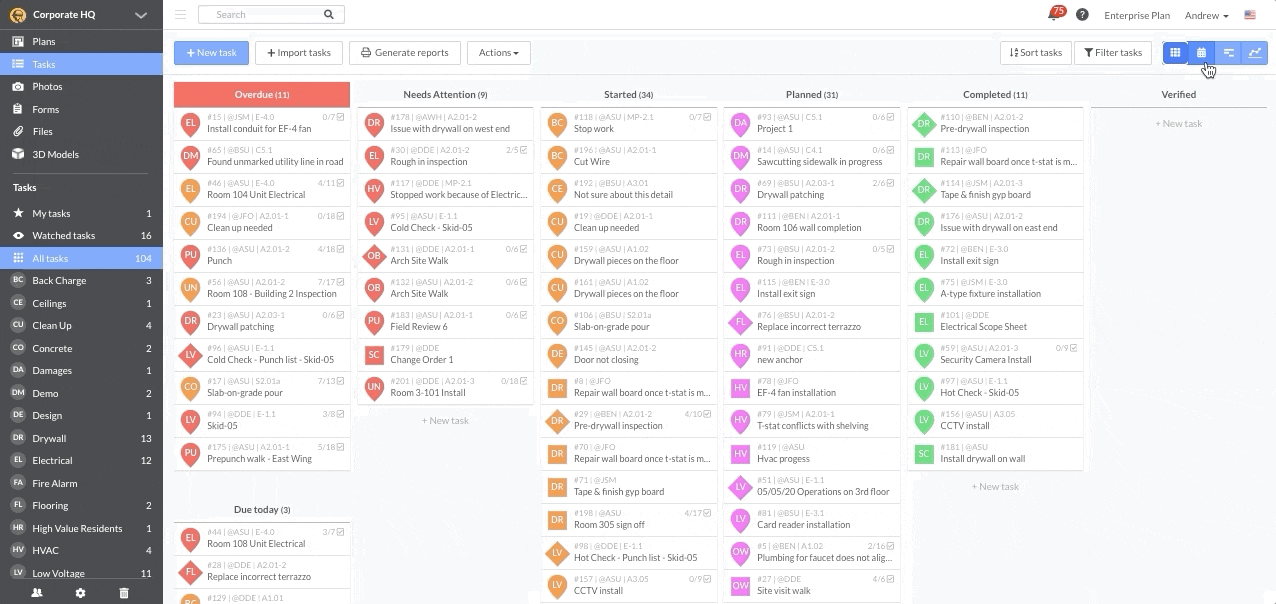
With Fieldwire, you can organize tasks, create and assign jobs, and manage priorities, documents, and instructions at any time. To keep track of time and cost expenses, you can assign your subcontractors work rates, get them to track their time spent on tasks and additional costs incurred on-site, and control project expenses and progress.
The software puts a great focus on mobile apps so that you and your team can see construction plans, blueprints, and markups, upload photos and documents, review tasks and schedules, track time, build reports, and more. The Fieldwire mobile app has excellent ratings in app stores, so we highly recommend it.
Pricing:
- Free version with basic functionality.
- Paid plans start at $39 per user/month.
Advantages (according to user reviews):
- Facilitates quality control.
- Allows for easy information-sharing.
- The mobile app is packed with handy features.
Disadvantages (according to user reviews):
- No task deadlines.
- Attachments are limited to 25 MB, while project plans often exceed 100 MB.
- Video recording to 8 seconds is limiting.
- You can’t add job site information such as the address, project manager, suppliers, customers, etc. for quick access.
2. RedTeam
Key features:
- Scheduling
- Contracts
- Change orders
- Submittals
- RFIs
- Reporting
RedTeam is a suite of construction project management software designed to minimize project risks and streamline tracking and analytics processes.
The software uses Gantt charts to record project task schedules and milestones and notifies project managers, superintendents, contractors, and subcontractors about changes in the schedule. It puts an emphasis on critical tasks and their deadlines to ensure compliance and adherence to the project schedule. More than that, it helps you take care of labor expenses, job costing, billing, and more.
Pricing:
- Plans start at $39 per user/month.
Advantages (according to user reviews):
- Excellent customer support.
- Allows for a systematic work process.
- Includes all the necessary features for project management.
Disadvantages (according to user reviews):
- Inconsistent user interfaces of desktop and mobile apps.
- User permissions are not customizable enough.
- Glitchy mobile app.
3. Autodesk Build
Key features:
- Schedule management
- Quality management
- Safety management
- Cost control
- Reporting
Autodesk Build is field and project management software that helps make construction more predictable, safe and sustainable.
:format(webp))
Autodesk Build’s configurable construction project management workflows connect the office and field, and keep your project on track:
- Gain real-time access to the latest schedule, share it with stakeholders and collaborate on it.
- Assign responsibilities for each step of the RFI process, link RFIs to other tasks, escalate Issues to RFIs, and RFIs to Potential Change Orders.
- Manage all submittals in a single submittal log, initiate submittal requests, manage reviews and approvals – all in a single piece of software.
Pricing:
- Free 30-day trial.
- Plans start at £157 per user/month.
Advantages (according to user reviews):
- Exceptional customer support.
- Seamless, real-time synchronization with other apps.
- Helps stakeholders to keep project budgets in check.
- Convenient file management and automated updates.
Disadvantages (according to user reviews):
- Doesn’t have the estimating capabilities.
- Poor user roles and permissions capabilities.
- Slow to use.
- Not a user-friendly interface.
4. Buildertrend
Key features:
- Project scheduling
- Budgeting
- Timesheets
- File management
- Mobile apps
Buildertrend is construction management software designed primarily for home builders, specialty contractors, home remodelers, and commercial contractors.

Schedule project activities, get a hawk’s eye view with Gantt charts, and sync tasks with Google Calendar, iCal, or Outlook. Get your team to document important information using voice-to-text notes and update notifications, and share photos and videos to keep you updated on the work progress. Get real-time work-in-progress reports to review total billings, profit margins, and costs.
Pricing:
- Plans start at $499 per month.
Advantages (according to user reviews):
- The Buildertrend team is attentive to users’ feedback.
- Makes team communication more efficient and less time-consuming.
- Build with construction businesses’ needs in mind.
Disadvantages (according to user reviews):
- Lack of estimating functionality.
- Extremely job-based. You must choose the job and then you can view the schedule, clock in, add notes, complete a checklist, etc.
- Overtime that is automatically calculated doesn’t automatically calculate a higher rate on the client’s budget.
- The learning curve is fairly steep.
- Product scalability is relatively weak.
5. coconstruct”>5. CoConstruct
Key features:
- Scheduling
- Job log
- Task manager
- Punch list
- Time clock management
- Budgeting
CoConstruct is construction management software that helps manage projects, clients, and contractors in a single environment.
First of all, CoConstruct helps you create and manage project schedules effectively using the Calendar view, a Gantt chart, drag-and-drop changes, predecessors, and critical path. After you make changes to the schedule, associated users will be notified about the changes by email or will be able to review their schedule in popular calendar tools like Outlook and Google Calendar using iCal integration.
CoConstruct also keeps your clients updated on the project progress with a dashboard where they can review project updates, costs, photos, conversations, and more.
Pricing:
- Contact the vendor for details.
Advantages (according to user reviews):
- Lets you involve clients in the project management process.
- Templates help to spend less time on proposal management.
- Easy to use.
Disadvantages (according to user reviews):
- The software is tailored to specific construction types and has difficulty when a business handles a variety of projects and needs to cross-project types.
- Limited customization capabilities.
- Limiting mobile apps: users complain that field workers have to use laptops instead of mobile apps and tablets.
- Proper data tracking requires paid upgrades.
🎁 Get Free Templates for Your Construction Projects Here
Project Management Software for Creatives
The ideal project management system for creatives should feel like a natural extension of the creative process itself, making life easier without stifling the magic:
- It’s got to be intuitive. Creatives thrive on flow and inspiration, not navigating complicated menus.
- Visualization is key. We’re talking drag-and-drop timelines, color-coded tasks, and customizable boards that give a bird’s-eye view of a project’s progress.
- Collaboration tools are important, too. Ideally, something that feels as easy as social media, but for sharing ideas, feedback, and files.
- Since inspiration strikes at the oddest hours, mobile accessibility is crucial.
- The software should sync well with other apps. Seamless integration with design tools, file-sharing platforms, and even social media channels can make a world of difference.
Here are the top project management systems for your creative projects:
1. Taiga
Key features:
- Scrum
- Kanban
- Issue tracking
- Reporting
- User roles & permissions
Taiga is online project management software for creatives designed for Agile, Scrum, and Kanban teams.
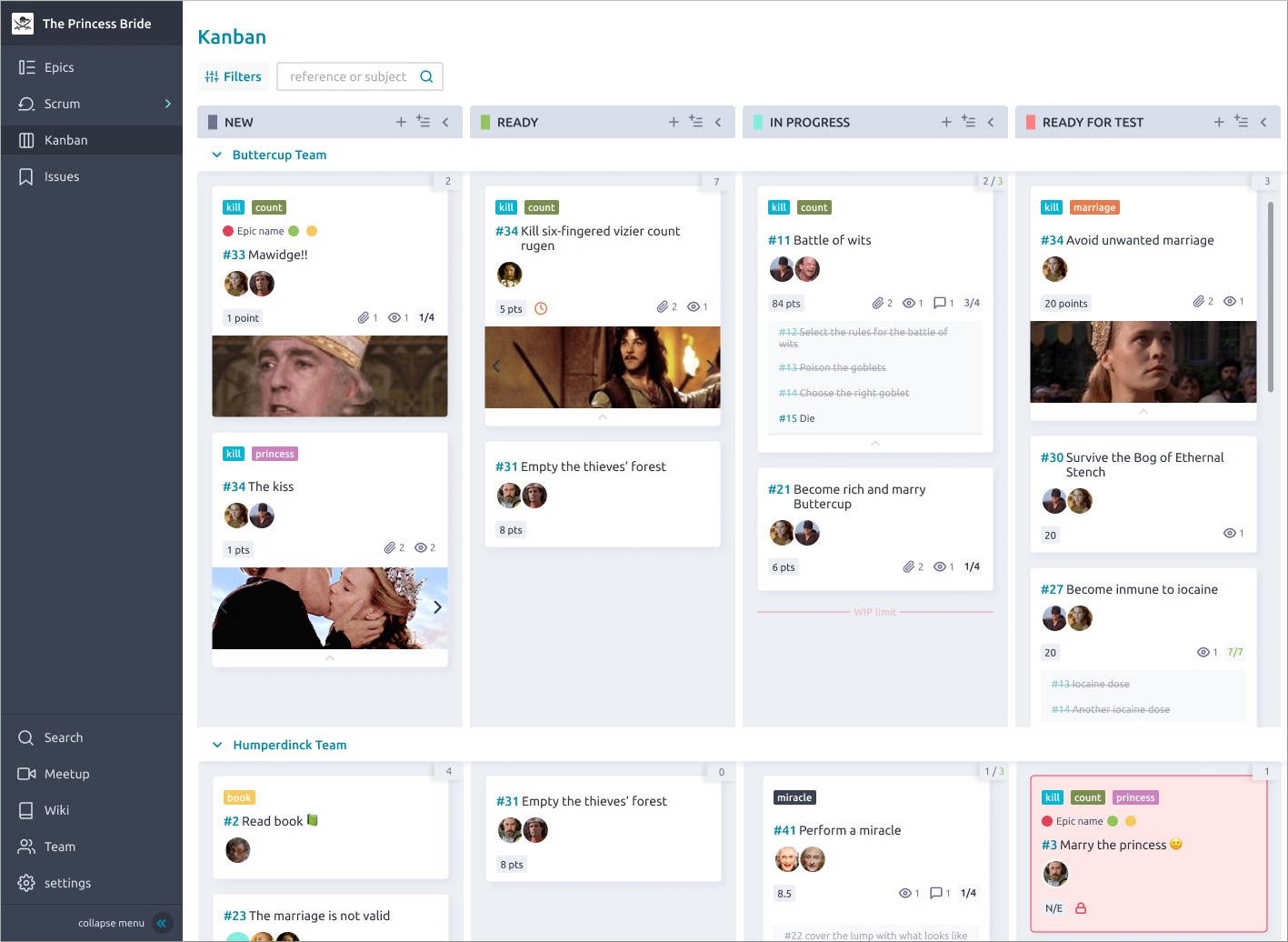
Taiga runs both in the cloud and on-premise and works best for small teams and simple projects. It is a project planning tool where you can break a project into tasks, create project-specific workflow and statuses, create custom fields for better project tracking and review project progress in Kanban boards and Sprint boards, and use burndown charts and issue boards.
Taiga is open-source, meaning you can customize it for your needs.
Pricing:
- Free basic version.
- Taiga with premium support costs $70 per month.
Advantages (according to user reviews):
- Perfect for personal and small projects.
- Suitable for agile frameworks.
- Improves collaboration.
Disadvantages (according to user reviews):
- You can create only 1 project for free.
- Software setup is time-consuming.
- It is not a good fit for complex projects.
- Poor scalability.
2. Teamwork
Key features:
- Project planning
- Task management
- Collaboration
- Recurring tasks
- Dependencies
- Mobile apps
Teamwork is project management software that helps creative teams deliver creative services work on time and on budget.
Build detailed project plans and assign tasks to one or more employees. Specify due dates, estimates, tags, and priorities, and review project progress using Kanban board, task list view, and Gantt chart. Get your team to track their time across activities for better project planning and accurate client billing. Choose from ready-to-use project templates to skip setup and get right to work.
Pricing:
- Free version for up to 5 users.
- Paid plans start at $9.99 per user/month.
Advantages (according to user reviews):
- Facilitates remote work.
- Automatic timers allow for accurate hour tracking.
- Contains lots of project management features.
Disadvantages (according to user reviews):
- Poor reporting and historical data evaluation.
- Requires IT staff to configure the software.
- May occasionally be buggy or malfunctioning.
- The mobile app is missing essential software features like project editing.
3. ActiveCollab
Key features:
- Work management
- Team collaboration
- Time management
- Resource management
- Budgeting
ActiveCollab is online project management software for creative professionals that allows you to set up your own work process, track time and see how your project is developing.
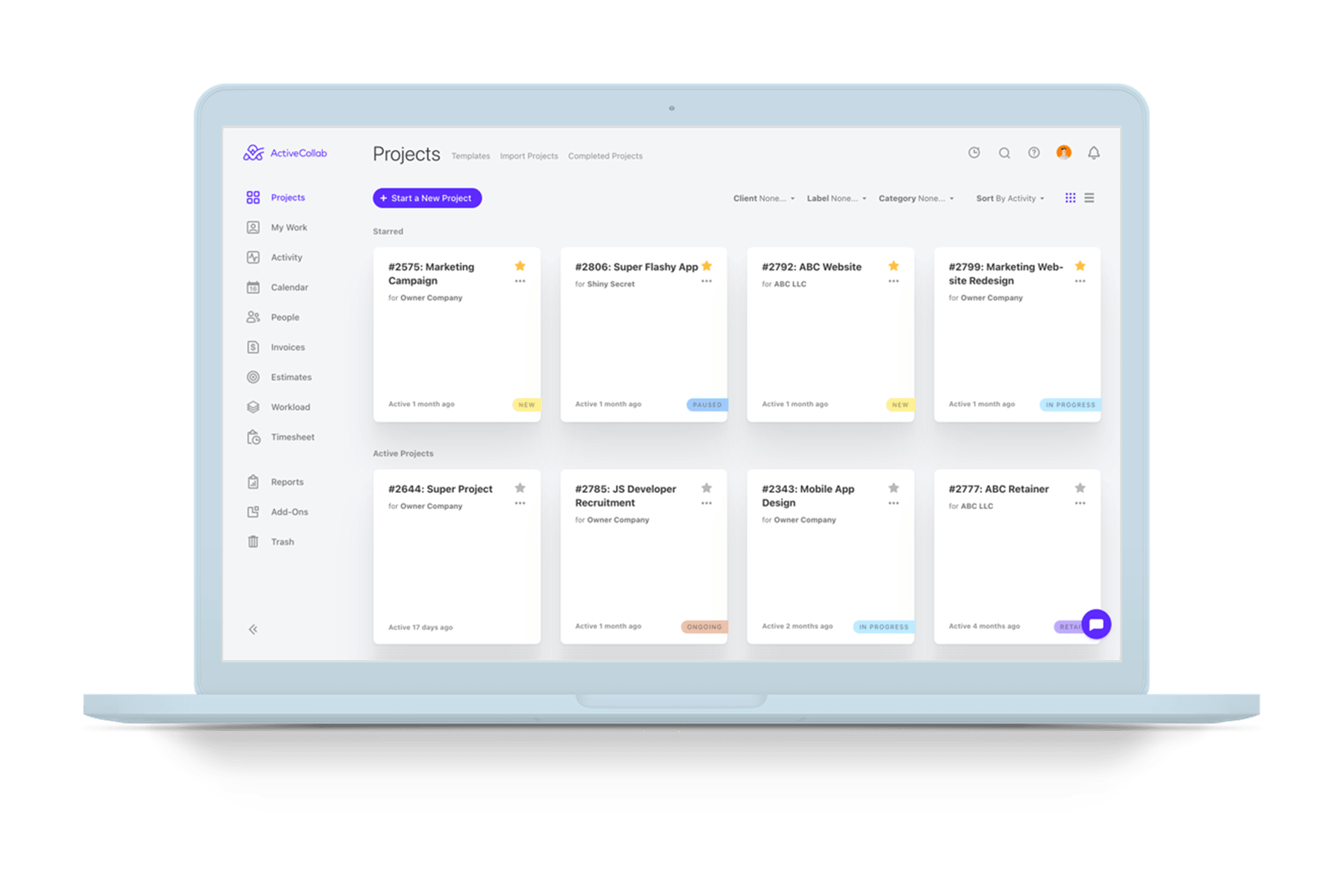
In ActiveCollab, you can create any number of projects or choose from ready-to-use templates, create tasks and subtasks, specify deadlines and responsible users, and switch between different project views, including Kanban, Gantt, list and calendar views to see how your projects are doing.
Unlike other project management tools, ActiveCollab allows you to create recurring tasks and create task dependencies to automate routine actions and never miss any tiny part of the project.
Pricing:
- Free 14-day trial.
- Plans start at $3.17 per user/month.
Advantages (according to user reviews):
- Great project planning features.
- Multiple views and versatile features.
- Beautiful design.
Disadvantages (according to user reviews):
- Hidden fees for features like time tracking, invoicing, and client portal.
- No task workflow feature.
- Time tracking could use improvement.
4. FunctionFox
Key features:
- Project schedules
- Time Tracking
- Budget tracking
- Reporting
FunctionFox is simple yet powerful online project management software for creative professionals – consultancies, creative agency teams, and in-house creative groups.
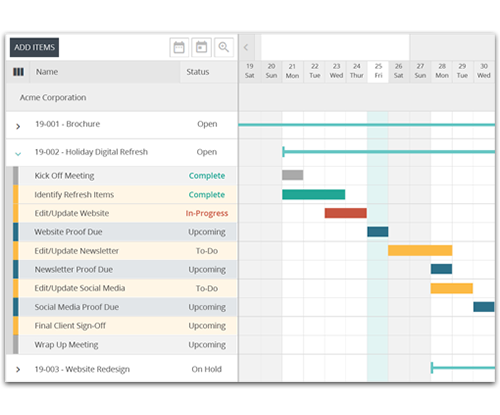
FunctionFox helps you track your work using Gantt charts and calendars, manage resources, create project schedules, and collaborate with one another. With time tracking, you can track team progress and run reports on clients, personnel, expenses, estimates, and more.
Pricing:
- Plans start at $10 per user/month.
Advantages (according to user reviews):
- All-in-one feature set.
- Easy to use and self-explanatory.
- Excellent customer support.
Disadvantages (according to user reviews):
- Reports lack customizability.
- Few accounting app integrations.
- Mobile apps crash often or don’t work at all.
5. Function Point
Key features:
- Workload forecasting
- Time Tracking
- File sharing
- Client portal
- Expense tracking
Function Point is project management software for creative agencies that displays your project plans, deadlines, budgets, files, briefs, and resources in a single place.

Function Point offers online timesheet tracking, combines it with custom settings and rates, and turns your data into transparent business performance overviews. More than that, it combines resource planning and financial and business reporting.
Pricing:
- Plans start at $45 per month.
Advantages (according to user reviews):
- Many features are customizable.
- Accessible from any device.
- Meets mid-sized agencies’ needs perfectly.
Disadvantages (according to user reviews):
- No task dependencies.
- Not suitable for large projects.
- Clunky interface and design.
6. Workamajig
Key features:
- Task management
- Resource management
- Budgeting
- Time tracking
- Reports
Workamajig is project management software built for creative agencies and in-house teams with features for resource management, and collaboration.
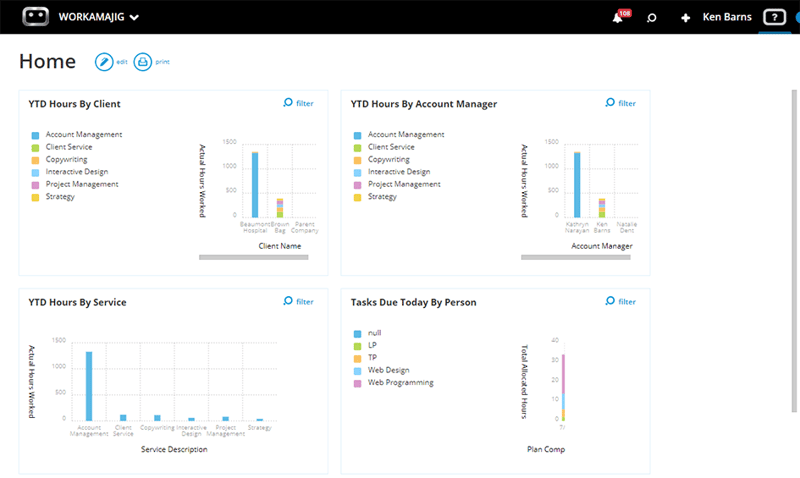
Workamajig can be different things: sales CRM, project management software, a resourcing & traffic tool, time and task tracker, accounting, and business intelligence solutions.
In terms of project management, it offers a single platform for managing tasks, conversations, calendars, budgets, and timelines. Review activity feed and budget expenses to stay informed of the project’s progress.
Pricing:
- Plans start at $37 per user/month.
Advantages (according to user reviews):
- Amazing reporting features.
- Lovable user interface.
- Can be integrated with CRM, time tracking, and other tools.
Disadvantages (according to user reviews):
- Cumbersome setup.
- Poor mobile support.
Project Management Software for Nonprofits
The ideal project management software for nonprofits balances functionality and simplicity, making it significantly easier for your team to focus on your mission rather than administrative tasks. Most importantly, it’s also cost-effective – it recognizes the budget constraints common within the nonprofit sector.
So, here are the two excellent project management systems that come with hefty discounts for non-profit organizations:
1. Todoist (Get 50% OFF)
Key features:
- Task management
- To-do lists
- Recurring tasks
- Task prioritization
- Calendar feeds
Todoist is task and project management software that is tailored for personal use but still offers team features and a team pricing plan.
Todoist can become a good companion to individual users and nonprofits because it helps you unload your mind, write out the tasks, delegate them if necessary, and gamify your efforts. Todoist is easily managed using the mobile app or web interface. It doesn’t have much to offer but is still pleasant to use.
Pricing:
- Free version for personal use.
- Paid plans start at $4 per user/month.
Advantages (according to user reviews):
- Beautiful user interface.
- Accessible from multiple devices.
- Helps to prioritize tasks.
Disadvantages (according to user reviews):
- Less than professional project management software.
- Not suitable for middle-size and large projects.
- Sluggish Chrome plugin.
2. GanttPRO (Get 50% OFF)
Key features:
- Workload management
- Gantt chart
- Board views
- Auto scheduling
- Time tracking
GanttPRO is project management software for small teams, including non-profit organizations.

GanttPRO allows you to manage multiple projects in a single tab and use ready-made templates to skip the setup part. Split your projects into tasks, subtasks, and milestones, organize and schedule them, and set due dates, durations, and dependencies. Review your project plan and resources in a Gantt chart.
The software also fosters team collaboration through assignments, team workflow, comments, attachments, changes history, and notifications.
Pricing:
- Free trial.
- Plans start at $7.99 per user/month.
Advantages (according to user reviews):
- Small learning curve.
- Intuitive drag-and-drop interface.
- Customizable templates save time.
- Allows for a visual approach to project management.
Disadvantages (according to user reviews):
- Kanban view has limited column options.
- Lacks notifications based on due dates or milestones.
- Lacks proper portfolio management.
- Slow to load.
- No mobile apps.
Project Management Software for Architects
Architects juggle numerous projects at once, each with its own set of deadlines, budgets, and specifications. Hence, their project management system should give them a bird’s eye view of it all, but also allow them to zoom in on the details when needed.
Besides, architecture projects are hardly solo gigs, so the software should allow for easy communication and file sharing among team members, clients, and contractors.
Then, the software should help track expenses in real time, allowing architects to stay on budget without breaking a sweat.
Lastly, it should integrate seamlessly with all the necessary design tools because architects don’t have the time to constantly switch between platforms throughout the day.
Here are a couple of such multifaceted and dynamic project management systems for architects:
1. Monograph
Key features:
- Project planning
- Resource management
- Time tracking
- Invoicing
- Reporting
Monograph is online project management software built specifically for architecture, landscape, and engineering firms.

Monograph offers the same familiar tools for managing projects and resources, but their interfaces are tailored for architects, design, and engineering professionals. For example, Monograph’s timesheet is designed in a manner that focuses on handling multiple projects with multiple types of activities at a time. Or it performs cost and progress analytics in a single MoneyGantt interface, which is a combination of a Gantt chart and cost analytics tools.
Monograph may look hard to navigate but developers claim that they are working on making it simple but insightful. More than that, the idea behind the software is old and true: it turns time tracking data into profitability, project progress, and other charts and reports.
Pricing:
- Contact the vendor for details.
Advantages (according to user reviews):
- Provides a good overview of projects.
- User-friendly interface.
- Handy reports.
Disadvantages (according to user reviews):
- Software development is still in progress
- Reporting, formatting, and integrations aren’t polished.
- Data visualization issues.
- No mobile and desktop access.
2. BQE Core
Key features:
- Performance dashboard
- Time tracking
- Billing & accounting
- Mobile apps
BQE Core is project management software for architects that focuses on time and cost expenses visualization for better project and resource planning.
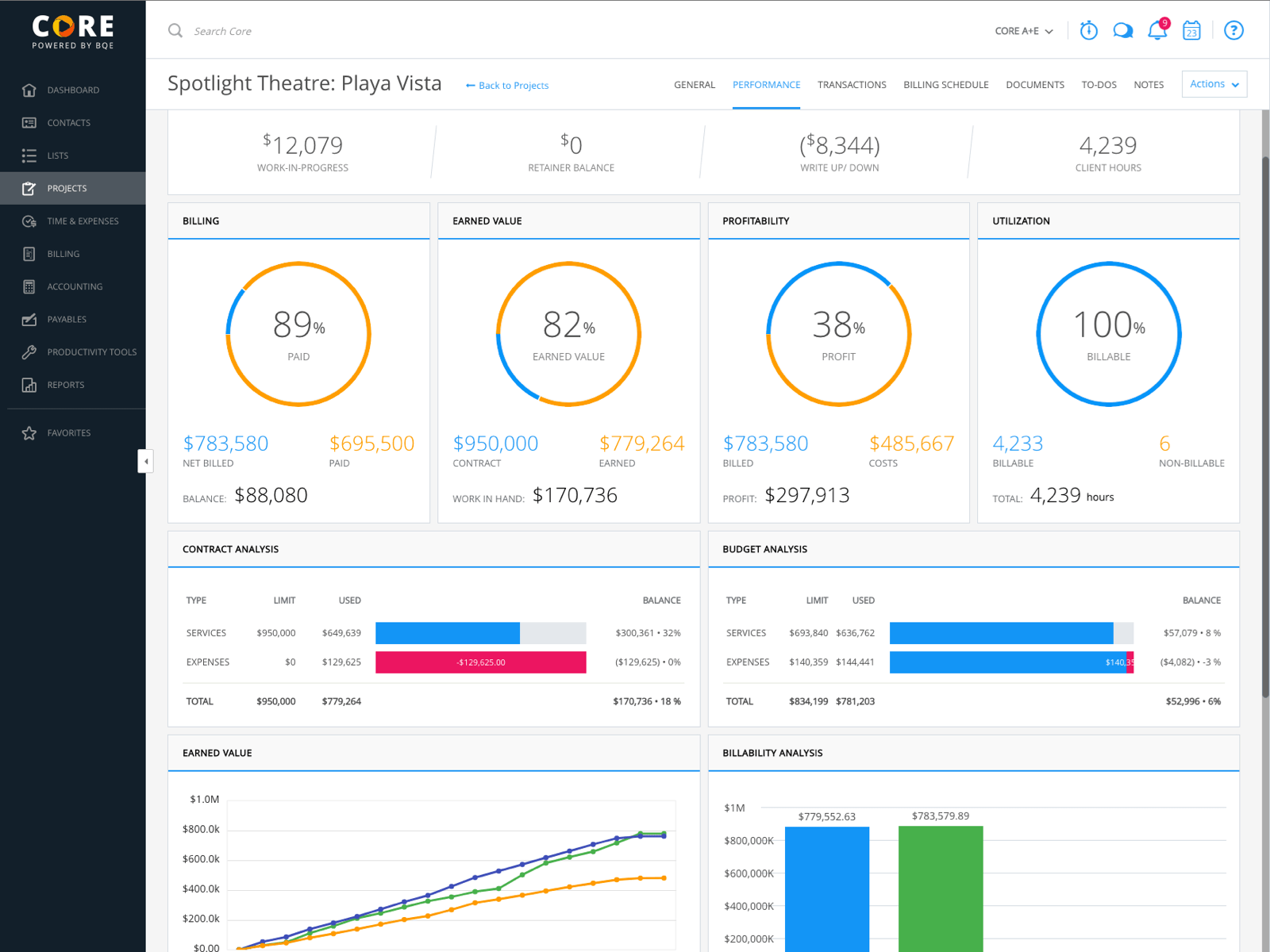
BQE Core relies on time tracking data to provide cost analytics. To enter work hours, you can choose between a spreadsheet-based Time Card format and a stopwatch. After you set up billing rates, you’ll be able to review project costs using chars that you can manage, customize, and add to your Dashboard.
What makes this software stand out is that it allows users to track overhead costs, such as insurance or transportation. These expenses will be added to the corresponding payrolls and expense reports, which not every software can boast.
Pricing:
- Request a quote from the vendor.
Advantages (according to user reviews):
- Responsive support team.
- Great expense management features.
Disadvantages (according to user reviews):
- The software saves time in 15-minute increments.
- Cumbersome reporting.
- Not suitable for small teams.
Project Management Software for Marketing
When scoping out project management software for marketing teams, there are a few essential qualities to look out for:
- Flexibility. Marketing projects are like snowflakes – no two are exactly the same. The software must adapt to various campaigns, whether it’s an email blast or a full-blown product launch.
- Real-time collaboration. Ideas flow at the speed of light in marketing teams, and the ability to capture this creativity instantly can be the difference between a good campaign and a viral one.
- Robust reporting and analytics. We live and die by our metrics, so being able to track every campaign’s ongoing performance helps us make data-driven decisions on the fly.
Below are a few project management systems that meet these criteria:
1. Workzone
Key features:
- Task dependencies
- Gantt chart
- Calendar view
- Time Tracking
- Collaboration
- Reports
Workzone is online project management software for marketing teams recognized by the most renowned software review platforms.
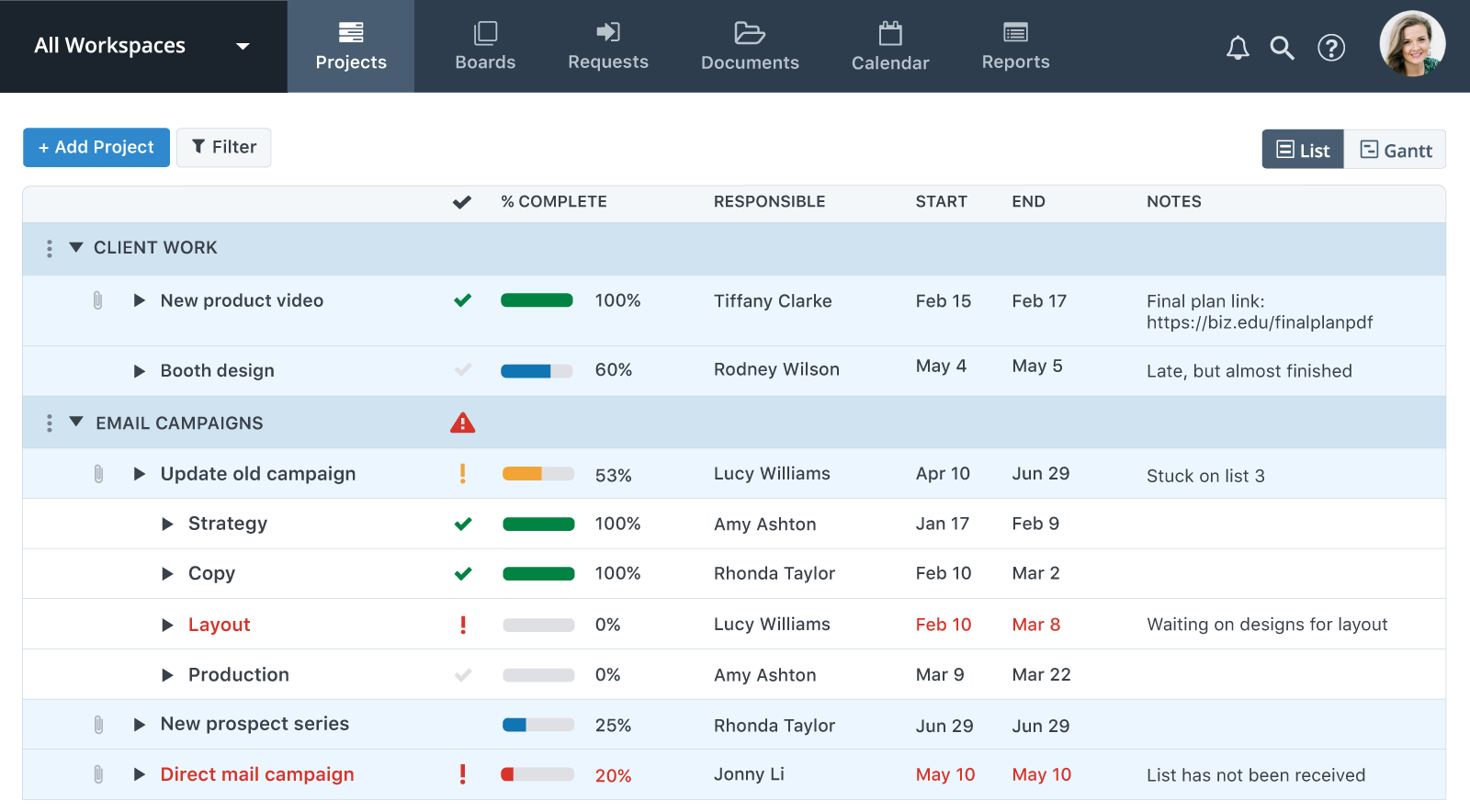
Workzone gives you an overview of ongoing projects in the dashboard interface:
- Use Gantt charts to review project schedules and task dependencies.
- Go to the group calendar to track event and project tasks.
- Get your team to track their working time and use this data to manage project costs and bill your clients.
- Go to the Workload report to see who is underutilized or overloaded.
Pricing:
- Free trial.
- Plans start at $24 per user/month.
Advantages (according to user reviews):
- The product team listens to users’ feedback and suggestions.
- Great customer support.
- Handy reports.
Disadvantages (according to user reviews):
- Steep learning curve.
- You can’t turn off unnecessary features.
- No mobile apps.
- Not cost-effective for small teams.
2. Forecast
Key features:
- Work automation
- Resource management
- Business intelligence
- Time Tracking
- Team collaboration
- Accounting
Forecast is project management software built around the idea of AI work automation tailored for project-oriented teams, like marketing teams.
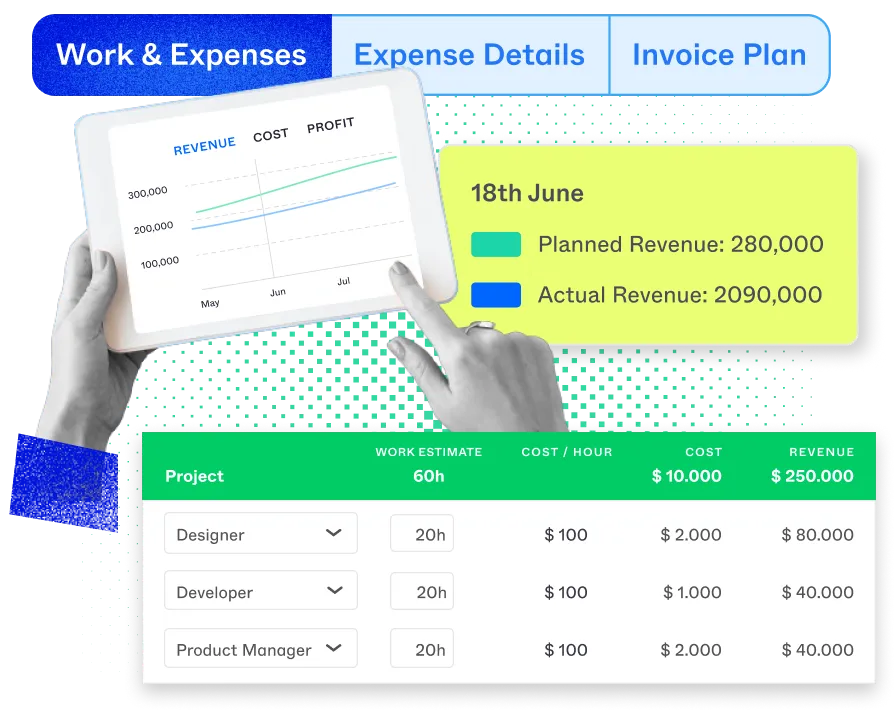
Forecast helps you plan projects, distribute the workload, meet project budgets, and more.
Plan sprints, and assign tasks with estimates and deadlines. After your team tracks time against their assignments, you’ll be able to review project progress using multiple project boards. What makes this software stand out is that it uses maths and machine learning AI to help you plan and forecast time and budgets. Is it reliable and powerful enough – use their free trial period to find out.
Pricing:
- Contact the vendor for details.
Advantages (according to user reviews):
- Intuitive and fast.
- AI-powered automation increases efficiency.
- Helps to control budgets.
Disadvantages (according to user reviews):
- Time tracking data sometimes goes missing.
- Not suitable for large projects and teams.
- Aggressive upselling.
- Hidden cancellation terms.
3. Birdview
Key features:
- Task dependencies
- Resource management
- Team collaboration
- Client portal
Birdview is online project management software for marketing agencies that promotes team collaboration and optimizes resources.
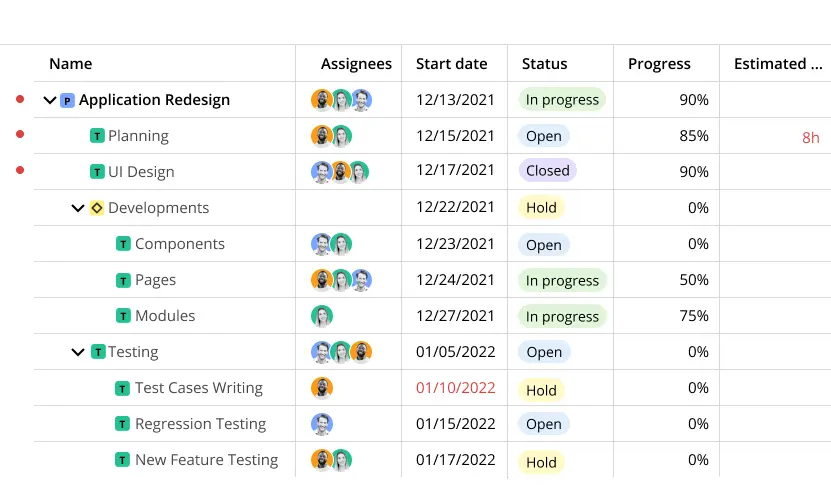
Birdview offers an Excel-like table view with status indicators, task parameters, and progress to help you get an overview of your project.
The Gantt chart view will help you visualize project progress and make quick adjustments to your project planning and strategy. The Kanban view helps teams deal with bottlenecks and focus on priority activities, while the color-coded calendar view helps you to see upcoming events and deadlines.
Pricing:
- Free 14-day trial.
- Plans start at $9 per user/month.
Advantages (according to user reviews):
- Straightforward interface.
- Makes it easy to manage multiple projects at once.
Disadvantages (according to user reviews):
- The mobile app has limited features.
- Not very customizable.
Ready to Implement the Best Online Project Management Software?
Project management software became a necessity in every team: it automates routines, helps managers build project schedules and manage workloads, highlights possible project risks, displays real-time analytics and reports, and more.
The variety of solutions is overwhelming and can take months and years to try. To help you set a quality standard from the start of your software quest, we recommend you explore actiTIME.
This time and project management software boasts flexibility to help you meet company and industry standards. It offers fully customizable work and task management modules, cost management to make sure that your projects never go beyond the budgets, time tracking to track resources and project progress, real-time widgets, charts, and reports to help you review your projects and teams at a glance.

Unlike other project management solutions in this list, actiTIME combines functionality with a user-friendly interface that you can start using right away, without training. Give it a try – get your free 30-day trial (no credit card required).











































